Faye Fite's Blog, page 23
November 25, 2016
Tea with Tumnus from C.S. Lewis's The Lion, the Witch and the Wardrobe: Sardines on Toast, Madeira Cake, and Tea
Every time I go somewhere new, I always have the urge to check for closets and wardrobes for Narnia.
I grew up reading Narnia. I have the entire boxed set, complete with the advertising stickers saying "Soon to be a major motion picture." My siblings and I read them so many times that the spines are cracked and some pages are fighting for liberation.
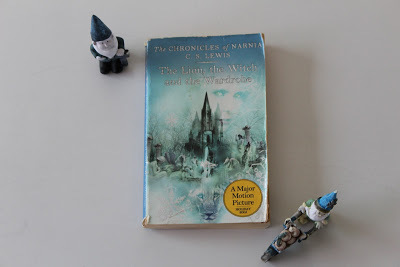 Because they're favorites of mine, and because I always associate
The Lion, the Witch and the Wardrobe
with Christmas time, I decided to make it my book of the month for this November.
Because they're favorites of mine, and because I always associate
The Lion, the Witch and the Wardrobe
with Christmas time, I decided to make it my book of the month for this November.
Which means I got to do a recipe inspired by said book. Which means I chose to do the Tea with Tumnus scene.
Which means I got to have over my favorite friend/writer/Tea with Tumnus expert: Susannah Metzler. Who has a blog called...that's right. Tea with Tumnus.
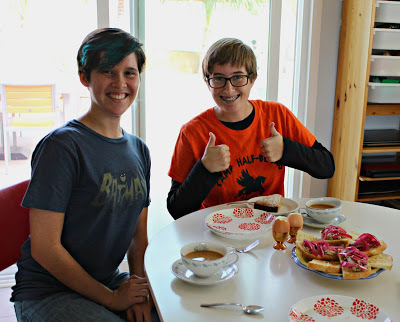 Her blog is completely awesome. She writes about writing, movies, books, filmscores, and pretty much any other awesome or nerdy thing that comes into her brilliant mind.
Her blog is completely awesome. She writes about writing, movies, books, filmscores, and pretty much any other awesome or nerdy thing that comes into her brilliant mind.
If you are not following her blog, you are making a terrible decision. Like, somebody-from-the-future-travels-back-in-time-to-warn-you terrible decision. So go follow her. Do not continue reading this post until you have followed her. Have you done it? Good. Onward! For Aslan!
I'm pretty sure we all know the plot of this book. If not, let me summarize:
A young, adventurous girl named Lucy stumbles through a wardrobe and into Narnia, a world frozen in eternal winter by the White Witch. The great lion Aslan has vanished, the people of Narnia live in fear, and there is always snow, but no Christmas. The rest of Lucy's siblings: Peter, Susan, and Edmund make their way into Narnia, but one of them is ensnared in the White Witch's web of power and deceit. All hope seems lost, but the return of Aslan brings about the beginning of great change...but at what cost to the great lion himself?
Both Susannah and myself are huge C.S. Lewis fans. We devoured the books as children and now, as writers, we look up to the author. There's something special about a book that young people read before growing up to become authors themselves. It pushes us to write harder, think deeper, to look back at what those books did for us as children and, in turn, want to be the author that propels other people into the world of writing and reading and magic. To Susannah and I, Narnia is one such series of books.
Needless to say, we were pretty excited about doing this Tea with Tumnus scene. We both got out our cameras. My Mom and I ran out to our local DAV to buy tea cups because I actually didn't own any and we all know that you can't do a post about a British book if you are void of tea cups. Susannah pulled out her British accent and I pulled out my recipes and we got to work.
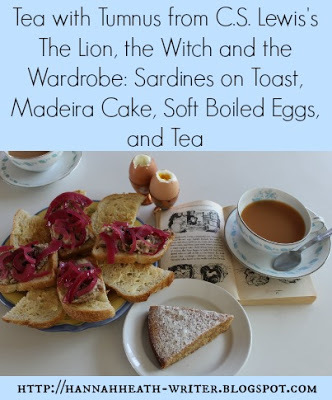 In the Tea with Tumnus scene, Tumnus lays out a delicious-sounding table of food for Lucy: Sardines on toast, soft boiled eggs, buttered toast, sugar-topped cake, and tea. I decided that the sugar-topped cake could possibly be madeira cake, an English sponge cake often eaten with tea. And we also made pickled red onions to go with the sardines, because, honestly, eating sardines with just bread seemed a bit gross.
In the Tea with Tumnus scene, Tumnus lays out a delicious-sounding table of food for Lucy: Sardines on toast, soft boiled eggs, buttered toast, sugar-topped cake, and tea. I decided that the sugar-topped cake could possibly be madeira cake, an English sponge cake often eaten with tea. And we also made pickled red onions to go with the sardines, because, honestly, eating sardines with just bread seemed a bit gross.
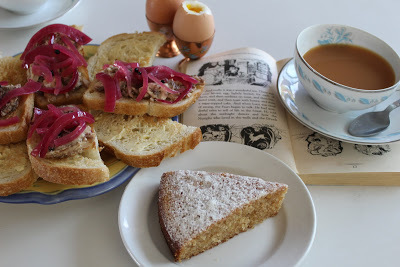 Susannah was really great about bearing with me and my recipe-making. When I do these posts I never really have an exact recipe in mind. I just...do things. And hope it tastes good. Which means there was a lot of wandering around the kitchen, me asking Susannah "Do you think this will work?" and us looking at each other, shrugging, and saying something along the lines of "It should be fine" or "Yeah, I don't think it will matter."
Susannah was really great about bearing with me and my recipe-making. When I do these posts I never really have an exact recipe in mind. I just...do things. And hope it tastes good. Which means there was a lot of wandering around the kitchen, me asking Susannah "Do you think this will work?" and us looking at each other, shrugging, and saying something along the lines of "It should be fine" or "Yeah, I don't think it will matter."
And it all turned out beautifully. Here, let me show you:
Sardines on ToastIngredients for pickled onions: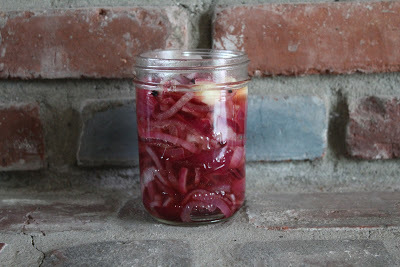
1 red onion, peeled, cut in half, and sliced1 tablespoon of red wine vinegar and 1 tablespoon of olive oil3/4 cup of a mixture of vinegar. We use a mixture of red wine vinegar and apple cider vinegar. Because apple cider vinegar is good for you. But you can use white vinegar if you'd like. 3 tablespoons of cane sugar. I didn't use my beloved coconut sugar because I think it would have given the pickles a weird molasses taste. 1 teaspoon of peppercorn1 clove of garlic, halved Directions:
1. In a sauce pan, saute the red onions in the tablespoon of red wine vinegar and olive oil. Don't let the onions brown. You just want them to soften. This takes about 5 minutes. Also, don't put your face over the pan while cooking. You'll burn your eyes.
2. In a saucepan, bring the vinegar mixture, sugar, and peppercorns to a boil until the sugar is dissolved.
3. Put the red onions in a mason jar along with the halved garlic. Now pour your vinegar over the onions. Let this sit for about an hour and voila! Ready to go!
They turned out really well. I think they should be able to store for about a week in the refrigerator, but I'm not sure. Susannah and I made them on Saturday and they were polished off by Monday.
Now you simply toast some bread (we used sourdough), open a can of sardines (which I understand sounds completely wrong, but just trust us), and put them on the bread, topping with the pickles. Awesome.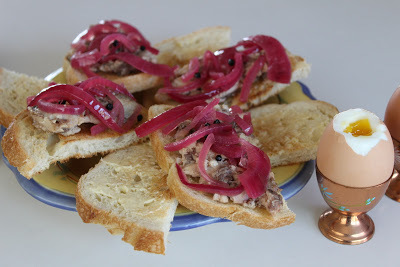
Madeira Cake This was an interesting recipe to develop because all of the other recipes I used as springboards were British and thus used ounces and grams. Also, English cooks seem to use a lot of "caster sugar." Which apparently is just fine white sugar, but with a Britified name. Who knew? Not me.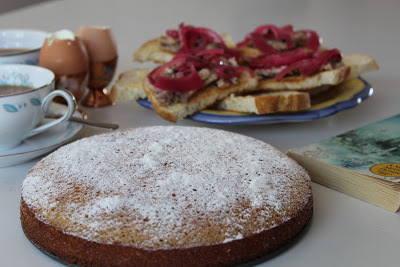
Ingredients: 1 cup of spelt, sifted. Spelt is an ancient, nutritious whole grain that has less gluten than modern wheat. 1 teaspoon of baking powder2/3 of a cup cane sugar. Again, I had to forsake my precious coconut sugar because it is too coarse and brown-sugar tasting for more delicate baked goods like madeira cake. 6 ounces of butter. We're both writers who are handicapped when it comes to math, but we were able to figure out how much of an 8.8 oz stick of butter we should use to get 6 oz. We're so smart.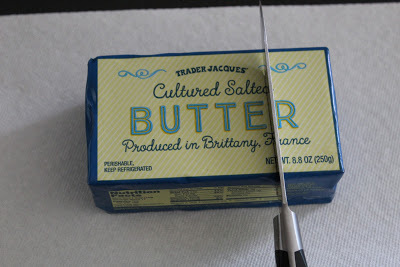 3 eggs1 teaspoon of orange zest 1 drop of orange essential oil, and one drop only. This stuff is very strong, so you don't want to overdo it. Directions:
3 eggs1 teaspoon of orange zest 1 drop of orange essential oil, and one drop only. This stuff is very strong, so you don't want to overdo it. Directions:
1. In a large bowl, beat together the butter and sugar until creamed (thoroughly mixed together and slightly stiff and, well...creamed). Once creamed, beat in one egg at a time. Next, add the orange oil and zest. Stir in the spelt and baking powder. The mixture should be neither runny nor doughy.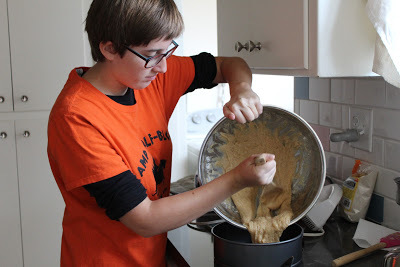 2. Oil a spring form pan or cake tin. Pour in the cake batter. Place in a 350 degree oven for about 20 minutes or until the top is slightly browned and a toothpick inserted into the center comes out clean.
2. Oil a spring form pan or cake tin. Pour in the cake batter. Place in a 350 degree oven for about 20 minutes or until the top is slightly browned and a toothpick inserted into the center comes out clean.
3. Allow to cool so that it's just warm, then dust with powdered sugar. It should be noted that the pan was still hot when we tried to dust it with sugar, which meant that Susannah was holding it with cumbersome oven mitts. It almost met a sad ending with the floor. So that's why you need to let it cool before trying to take it out of the spring form pan.
Anyway, look how pretty it is: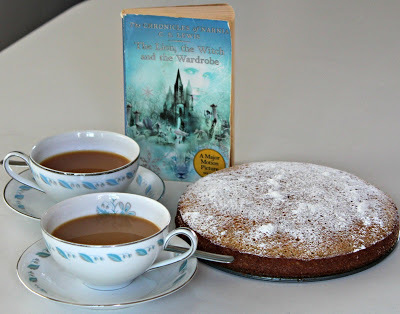 Soft boiled eggs
Soft boiled eggs
Or dippy eggs. Whatever you want to call them. All you do is bring water to a boil, then lower it to a simmer, add your eggs, and cook for 5 minutes. When the 5 minutes are up, immediately run under cool water.
Next, use the blunt side of a butter knife to crack along the top of the egg, then remove the top. That simple. If you Google "How to make soft-boiled eggs" you will come across about forty two different ways to do it. So, if you like another method, go for it.
Now make yourself your favorite type of tea. Susannah brought over organic Earl Grey tea and we drank it in our fancy tea cups. Very classy.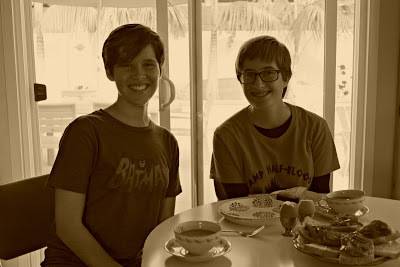 As I needed pictures for this blog post, and because Susannah is an awesome photographer, we did a food photoshoot and ended up eating our meal semi-cold. But it doesn't matter, because it still tasted great and, more importantly, we got some awesome pictures:
As I needed pictures for this blog post, and because Susannah is an awesome photographer, we did a food photoshoot and ended up eating our meal semi-cold. But it doesn't matter, because it still tasted great and, more importantly, we got some awesome pictures:
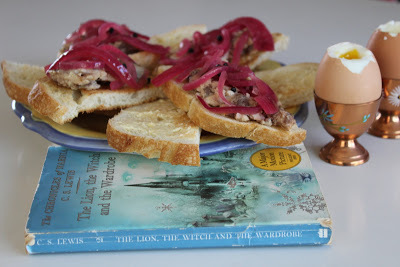
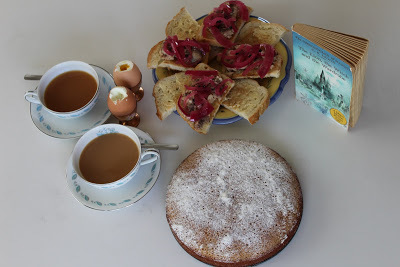 I even got a shot of the photographer in her natural habitat:
I even got a shot of the photographer in her natural habitat:
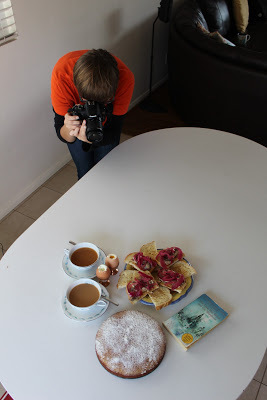 After photos, we demolished the food.
After photos, we demolished the food.
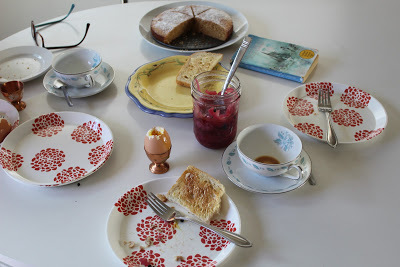 It was just that good. We decided that the pickled onions were definitely something we would eat on a regular basis, thought the madeira cake was the best thing ever, and discovered the joys of Irish breakfast tea. I think if we had laid out this food next to a cozy fireplace, Lucy wouldn't have known that Tumnus didn't make it.
It was just that good. We decided that the pickled onions were definitely something we would eat on a regular basis, thought the madeira cake was the best thing ever, and discovered the joys of Irish breakfast tea. I think if we had laid out this food next to a cozy fireplace, Lucy wouldn't have known that Tumnus didn't make it.
Needless to say, we had a blast. All thanks to good food, C.S. Lewis, and friendship. Three of the best things on the face of the planet.
Have you read The Lion, the Witch and the Wardrobe? What is your favorite book from the Narnia series? Favorite C.S. Lewis novel? Please leave a comment below! And don't forget to follow Susannah's blog, twitter, Pinterest, and Goodreads. You don't want to disturb that time traveler, do you?
Related articles: Gluten and Dairy Free Seed-cake, Apple-tart, and Nut Round Recipes Inspired by The Hobbit by J.R.R. TolkienPumpkin Juice Inspired by J.K. Rowling's Harry Potter and the Chamber of SecretsGluten-Free Orange And Clove Scone Inspired by G.K. Chesterton
Enjoy this post? Take a look around! If you like what you see, subscribe by email for a new post every Friday!
Some links are Amazon Affiliate. Thank you for your support!
I grew up reading Narnia. I have the entire boxed set, complete with the advertising stickers saying "Soon to be a major motion picture." My siblings and I read them so many times that the spines are cracked and some pages are fighting for liberation.
 Because they're favorites of mine, and because I always associate
The Lion, the Witch and the Wardrobe
with Christmas time, I decided to make it my book of the month for this November.
Because they're favorites of mine, and because I always associate
The Lion, the Witch and the Wardrobe
with Christmas time, I decided to make it my book of the month for this November.Which means I got to do a recipe inspired by said book. Which means I chose to do the Tea with Tumnus scene.
Which means I got to have over my favorite friend/writer/Tea with Tumnus expert: Susannah Metzler. Who has a blog called...that's right. Tea with Tumnus.
 Her blog is completely awesome. She writes about writing, movies, books, filmscores, and pretty much any other awesome or nerdy thing that comes into her brilliant mind.
Her blog is completely awesome. She writes about writing, movies, books, filmscores, and pretty much any other awesome or nerdy thing that comes into her brilliant mind.If you are not following her blog, you are making a terrible decision. Like, somebody-from-the-future-travels-back-in-time-to-warn-you terrible decision. So go follow her. Do not continue reading this post until you have followed her. Have you done it? Good. Onward! For Aslan!
I'm pretty sure we all know the plot of this book. If not, let me summarize:
A young, adventurous girl named Lucy stumbles through a wardrobe and into Narnia, a world frozen in eternal winter by the White Witch. The great lion Aslan has vanished, the people of Narnia live in fear, and there is always snow, but no Christmas. The rest of Lucy's siblings: Peter, Susan, and Edmund make their way into Narnia, but one of them is ensnared in the White Witch's web of power and deceit. All hope seems lost, but the return of Aslan brings about the beginning of great change...but at what cost to the great lion himself?
Both Susannah and myself are huge C.S. Lewis fans. We devoured the books as children and now, as writers, we look up to the author. There's something special about a book that young people read before growing up to become authors themselves. It pushes us to write harder, think deeper, to look back at what those books did for us as children and, in turn, want to be the author that propels other people into the world of writing and reading and magic. To Susannah and I, Narnia is one such series of books.
Needless to say, we were pretty excited about doing this Tea with Tumnus scene. We both got out our cameras. My Mom and I ran out to our local DAV to buy tea cups because I actually didn't own any and we all know that you can't do a post about a British book if you are void of tea cups. Susannah pulled out her British accent and I pulled out my recipes and we got to work.
 In the Tea with Tumnus scene, Tumnus lays out a delicious-sounding table of food for Lucy: Sardines on toast, soft boiled eggs, buttered toast, sugar-topped cake, and tea. I decided that the sugar-topped cake could possibly be madeira cake, an English sponge cake often eaten with tea. And we also made pickled red onions to go with the sardines, because, honestly, eating sardines with just bread seemed a bit gross.
In the Tea with Tumnus scene, Tumnus lays out a delicious-sounding table of food for Lucy: Sardines on toast, soft boiled eggs, buttered toast, sugar-topped cake, and tea. I decided that the sugar-topped cake could possibly be madeira cake, an English sponge cake often eaten with tea. And we also made pickled red onions to go with the sardines, because, honestly, eating sardines with just bread seemed a bit gross. Susannah was really great about bearing with me and my recipe-making. When I do these posts I never really have an exact recipe in mind. I just...do things. And hope it tastes good. Which means there was a lot of wandering around the kitchen, me asking Susannah "Do you think this will work?" and us looking at each other, shrugging, and saying something along the lines of "It should be fine" or "Yeah, I don't think it will matter."
Susannah was really great about bearing with me and my recipe-making. When I do these posts I never really have an exact recipe in mind. I just...do things. And hope it tastes good. Which means there was a lot of wandering around the kitchen, me asking Susannah "Do you think this will work?" and us looking at each other, shrugging, and saying something along the lines of "It should be fine" or "Yeah, I don't think it will matter."And it all turned out beautifully. Here, let me show you:
Sardines on ToastIngredients for pickled onions:

1 red onion, peeled, cut in half, and sliced1 tablespoon of red wine vinegar and 1 tablespoon of olive oil3/4 cup of a mixture of vinegar. We use a mixture of red wine vinegar and apple cider vinegar. Because apple cider vinegar is good for you. But you can use white vinegar if you'd like. 3 tablespoons of cane sugar. I didn't use my beloved coconut sugar because I think it would have given the pickles a weird molasses taste. 1 teaspoon of peppercorn1 clove of garlic, halved Directions:
1. In a sauce pan, saute the red onions in the tablespoon of red wine vinegar and olive oil. Don't let the onions brown. You just want them to soften. This takes about 5 minutes. Also, don't put your face over the pan while cooking. You'll burn your eyes.
2. In a saucepan, bring the vinegar mixture, sugar, and peppercorns to a boil until the sugar is dissolved.
3. Put the red onions in a mason jar along with the halved garlic. Now pour your vinegar over the onions. Let this sit for about an hour and voila! Ready to go!
They turned out really well. I think they should be able to store for about a week in the refrigerator, but I'm not sure. Susannah and I made them on Saturday and they were polished off by Monday.
Now you simply toast some bread (we used sourdough), open a can of sardines (which I understand sounds completely wrong, but just trust us), and put them on the bread, topping with the pickles. Awesome.

Madeira Cake This was an interesting recipe to develop because all of the other recipes I used as springboards were British and thus used ounces and grams. Also, English cooks seem to use a lot of "caster sugar." Which apparently is just fine white sugar, but with a Britified name. Who knew? Not me.

Ingredients: 1 cup of spelt, sifted. Spelt is an ancient, nutritious whole grain that has less gluten than modern wheat. 1 teaspoon of baking powder2/3 of a cup cane sugar. Again, I had to forsake my precious coconut sugar because it is too coarse and brown-sugar tasting for more delicate baked goods like madeira cake. 6 ounces of butter. We're both writers who are handicapped when it comes to math, but we were able to figure out how much of an 8.8 oz stick of butter we should use to get 6 oz. We're so smart.
 3 eggs1 teaspoon of orange zest 1 drop of orange essential oil, and one drop only. This stuff is very strong, so you don't want to overdo it. Directions:
3 eggs1 teaspoon of orange zest 1 drop of orange essential oil, and one drop only. This stuff is very strong, so you don't want to overdo it. Directions: 1. In a large bowl, beat together the butter and sugar until creamed (thoroughly mixed together and slightly stiff and, well...creamed). Once creamed, beat in one egg at a time. Next, add the orange oil and zest. Stir in the spelt and baking powder. The mixture should be neither runny nor doughy.
 2. Oil a spring form pan or cake tin. Pour in the cake batter. Place in a 350 degree oven for about 20 minutes or until the top is slightly browned and a toothpick inserted into the center comes out clean.
2. Oil a spring form pan or cake tin. Pour in the cake batter. Place in a 350 degree oven for about 20 minutes or until the top is slightly browned and a toothpick inserted into the center comes out clean.3. Allow to cool so that it's just warm, then dust with powdered sugar. It should be noted that the pan was still hot when we tried to dust it with sugar, which meant that Susannah was holding it with cumbersome oven mitts. It almost met a sad ending with the floor. So that's why you need to let it cool before trying to take it out of the spring form pan.
Anyway, look how pretty it is:
 Soft boiled eggs
Soft boiled eggsOr dippy eggs. Whatever you want to call them. All you do is bring water to a boil, then lower it to a simmer, add your eggs, and cook for 5 minutes. When the 5 minutes are up, immediately run under cool water.
Next, use the blunt side of a butter knife to crack along the top of the egg, then remove the top. That simple. If you Google "How to make soft-boiled eggs" you will come across about forty two different ways to do it. So, if you like another method, go for it.
Now make yourself your favorite type of tea. Susannah brought over organic Earl Grey tea and we drank it in our fancy tea cups. Very classy.
 As I needed pictures for this blog post, and because Susannah is an awesome photographer, we did a food photoshoot and ended up eating our meal semi-cold. But it doesn't matter, because it still tasted great and, more importantly, we got some awesome pictures:
As I needed pictures for this blog post, and because Susannah is an awesome photographer, we did a food photoshoot and ended up eating our meal semi-cold. But it doesn't matter, because it still tasted great and, more importantly, we got some awesome pictures:

 I even got a shot of the photographer in her natural habitat:
I even got a shot of the photographer in her natural habitat:
 After photos, we demolished the food.
After photos, we demolished the food.
 It was just that good. We decided that the pickled onions were definitely something we would eat on a regular basis, thought the madeira cake was the best thing ever, and discovered the joys of Irish breakfast tea. I think if we had laid out this food next to a cozy fireplace, Lucy wouldn't have known that Tumnus didn't make it.
It was just that good. We decided that the pickled onions were definitely something we would eat on a regular basis, thought the madeira cake was the best thing ever, and discovered the joys of Irish breakfast tea. I think if we had laid out this food next to a cozy fireplace, Lucy wouldn't have known that Tumnus didn't make it. Needless to say, we had a blast. All thanks to good food, C.S. Lewis, and friendship. Three of the best things on the face of the planet.
Have you read The Lion, the Witch and the Wardrobe? What is your favorite book from the Narnia series? Favorite C.S. Lewis novel? Please leave a comment below! And don't forget to follow Susannah's blog, twitter, Pinterest, and Goodreads. You don't want to disturb that time traveler, do you?
Related articles: Gluten and Dairy Free Seed-cake, Apple-tart, and Nut Round Recipes Inspired by The Hobbit by J.R.R. TolkienPumpkin Juice Inspired by J.K. Rowling's Harry Potter and the Chamber of SecretsGluten-Free Orange And Clove Scone Inspired by G.K. Chesterton
Enjoy this post? Take a look around! If you like what you see, subscribe by email for a new post every Friday!
Some links are Amazon Affiliate. Thank you for your support!

Published on November 25, 2016 06:17
November 18, 2016
Darkness in Fiction: 7 Tips for Writing Dark Stories
I enjoy dark stories. I like reading about characters that struggle, worlds on the brink of destruction and in need of saving, words that go into the deep, little-seen parts of the soul. I like writing them, too.
And that's why I'm so disturbed by what darkness in fiction has turned into. It seems like each year the books get darker and darker, and each year they become more and more abused by authors who don't seem to understand (or care about) the ramifications of their words.
As a writer and lover of stories with a dark side, I'd like to point out what makes a dark story good with the hopes that we can get away from the current "Darkness without meaning" trend that's running around like a rabid dog (*cough* or a certain DC director who thought it would be a good idea to turn a certain character into a murderer *cough* *cough*). So here it is: 7 tips for writing a dark story that's not just a black hole of death and depression and strangled puppies.
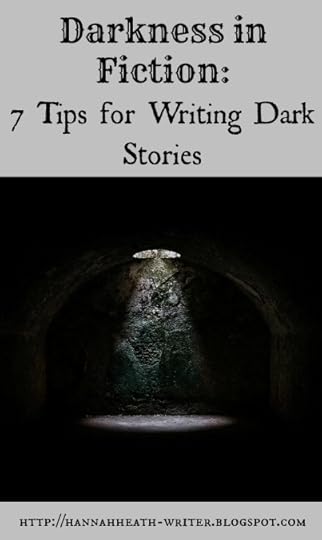 1. The darkness must have meaning to it. This is the most important thing to remember about writing a dark piece of fiction. Do you know what it is that makes dark stories so good? The light in them. That may seem a bit counterintuitive, but it's not. Just stop and think about it for a second. Why do we like dark characters like Loki and Snape? Because we see broken people struggling against the world (and themselves). We see them fighting (or having the potential to fight) to make themselves better. Why do we like dystopian novels? Because we get to see a world or a people rebel and work hard to get out of the darkness. We like reading about characters combating tough situations because it inspires us and shows us that we can work through our problems, too. That's what makes darkness in fiction so alluring. Not the darkness, but what people can glimpse on the other side. The meaning, the purpose, the light. So if you're only going to listen to one thing said in this post, listen to this: Make sure there is a reason and a purpose behind the darkness in your story. Ask yourself: What are you trying to say? What do you want your readers to learn? Make it your goal to show the world something through the darkness.
1. The darkness must have meaning to it. This is the most important thing to remember about writing a dark piece of fiction. Do you know what it is that makes dark stories so good? The light in them. That may seem a bit counterintuitive, but it's not. Just stop and think about it for a second. Why do we like dark characters like Loki and Snape? Because we see broken people struggling against the world (and themselves). We see them fighting (or having the potential to fight) to make themselves better. Why do we like dystopian novels? Because we get to see a world or a people rebel and work hard to get out of the darkness. We like reading about characters combating tough situations because it inspires us and shows us that we can work through our problems, too. That's what makes darkness in fiction so alluring. Not the darkness, but what people can glimpse on the other side. The meaning, the purpose, the light. So if you're only going to listen to one thing said in this post, listen to this: Make sure there is a reason and a purpose behind the darkness in your story. Ask yourself: What are you trying to say? What do you want your readers to learn? Make it your goal to show the world something through the darkness.
2. Dark does not mean twisted, brutal, or gory. Keep that locked up in your mind. It's important. You don't have to have a guy cut people up with a chainsaw to make a story dark. Or a story told from the POV of a schizophrenic sadist. You do not have to stoop to gallons of blood and gore and general disturbedness (Don't start with me. My blog, my words) to make a story dark. So before you decide to stuff a fridge with dead people to set the mood for your story, think again. Try for some cleverness or subtlety and, well...
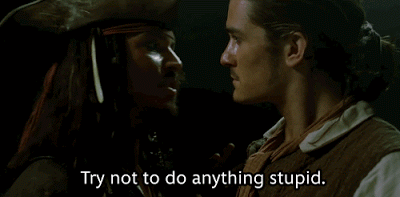
3. Try using a light mood. That's right. Dark stories can have a lightness to them. Your characters are allowed to joke. Your writing style is allowed to be funny. Your world can have rainbows and flowers and candy in it. You don't have to go overboard with it if it doesn't fit the story, but you also shouldn't be going full-on Dementor, either. Take The Book Thief, for example. It's told from Death's POV, which you'd think would make it extremely morbid. But it doesn't because Zusak gave Death a certain sense of humor and put in several funny scenes featuring Rudy's antics, while also weaving a dark, touching, and profound story. It's possible, it works, and it saves your readers from feeling like they're being drowned in dead dreams, children's tears, and a world void of chocolate.
4. Dark settings are not an excuse for lack of morals. You know of what I speak. The apocalyptic books where the teens decide it's okay to run off and have sex because hey, they'll all be dead soon, so it doesn't really matter. Or the fantasy worlds where the "heroes" kill people without a thought because this is war and those are just faceless characters. Seriously? No. Tough situations do not allow bad behavior. Which character do you want to read about: The one who's trying hard to do what's right even when everything is wrong? Or the one that's just going with the flow because everything's gone to hell already, so why bother? Which of these characters do you think is helpful and inspiring? And which is extremely damaging? Think about what it is you are writing. Words have impact and meaning. Do not abuse that.
5. "And they all died" is not a necessary ending. Some stories can end this way if that is their natural course, but don't just do it in an attempt to devastate your readers or the one living character. Death and unnecessary darkness does not make a good book.
6. Go deep and complex with your characters. This is something you should be doing with all kinds of stories, but it is especially important when it comes to dark stories. People don't make sense under normal circumstances. We are walking paradoxes, natural hypocrites, and a mixture of everything that is both right and wrong with the world we live in. This becomes more and more apparent when we're put under stress. Reflect this in your story. Your heroes do not have to be 100% good, nor your villains 100% evil. They each should have goals, contradictions, character flaws, deep, dark secrets, and admirable traits. This adds a realism that is an important component to dark stories.
7. Everything does not need to be wrapped up nicely at the end. The world is messy. It often doesn't make sense. There are questions we cannot answer and problems we cannot solve (or even fathom). Don't feel like you need to have an answer and solution to all of the darkness in your story. You need to have a point and something your readers can take away from it, yes. But you don't need to answer the question to life, the universe, and everything. All that really matters is that the characters find a way out of the darkness...or at least find a way to live within it.
If you're looking for good examples of good dark stories, I have a list.
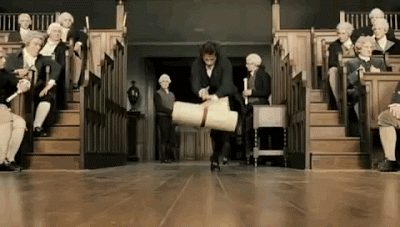 In no particular order:
A Monster Calls
, Frankenstein, Dracula Untold, The Knife of Never Letting Go,
The Book Thief
, The Patriot,
1984
, Crime and Punishment,
PandoraHearts
, The Dark Knight, Maus I and II,
Wool
, The Pearl, Gladiator,
The Yellow Wallpaper
, The Dark Knight Returns, I Am Legend, Harry Potter, Lord of the Flies, The Grey, The Children of Hurin, Lord of the Rings (both the books and movies had some dark elements to them). Okay, so maybe Harry Potter isn't particularly dark, but it has some semi-dark characters that I think were expertly handled (Snape, Draco Malfoy).
In no particular order:
A Monster Calls
, Frankenstein, Dracula Untold, The Knife of Never Letting Go,
The Book Thief
, The Patriot,
1984
, Crime and Punishment,
PandoraHearts
, The Dark Knight, Maus I and II,
Wool
, The Pearl, Gladiator,
The Yellow Wallpaper
, The Dark Knight Returns, I Am Legend, Harry Potter, Lord of the Flies, The Grey, The Children of Hurin, Lord of the Rings (both the books and movies had some dark elements to them). Okay, so maybe Harry Potter isn't particularly dark, but it has some semi-dark characters that I think were expertly handled (Snape, Draco Malfoy).
Also, shameless plug: Skies of Dripping Gold is a good dark story, too. And no, I didn't just write this entire post so I could say that. I promise.
If you want more, let me know. If you disagree with any of them, let me know. If you want to add some to the list, let me know. Basically, if you have anything at all to say about this post, let me know. I love receiving comments!
Related articles:
The Importance of Asking Why: 4 Questions You Should Ask Yourself as a Writer
Why There's No Such Thing As "Just A Story"
Keeping it Classy: When is it OK to Use Profanity in Your Fiction Writing
Enjoy this post? Take a look around. If you like what you see, please don't forget to subscribe by email for a new post every Friday!
Some links are Amazon Affiliate. Thank you for your support!

And that's why I'm so disturbed by what darkness in fiction has turned into. It seems like each year the books get darker and darker, and each year they become more and more abused by authors who don't seem to understand (or care about) the ramifications of their words.
As a writer and lover of stories with a dark side, I'd like to point out what makes a dark story good with the hopes that we can get away from the current "Darkness without meaning" trend that's running around like a rabid dog (*cough* or a certain DC director who thought it would be a good idea to turn a certain character into a murderer *cough* *cough*). So here it is: 7 tips for writing a dark story that's not just a black hole of death and depression and strangled puppies.
 1. The darkness must have meaning to it. This is the most important thing to remember about writing a dark piece of fiction. Do you know what it is that makes dark stories so good? The light in them. That may seem a bit counterintuitive, but it's not. Just stop and think about it for a second. Why do we like dark characters like Loki and Snape? Because we see broken people struggling against the world (and themselves). We see them fighting (or having the potential to fight) to make themselves better. Why do we like dystopian novels? Because we get to see a world or a people rebel and work hard to get out of the darkness. We like reading about characters combating tough situations because it inspires us and shows us that we can work through our problems, too. That's what makes darkness in fiction so alluring. Not the darkness, but what people can glimpse on the other side. The meaning, the purpose, the light. So if you're only going to listen to one thing said in this post, listen to this: Make sure there is a reason and a purpose behind the darkness in your story. Ask yourself: What are you trying to say? What do you want your readers to learn? Make it your goal to show the world something through the darkness.
1. The darkness must have meaning to it. This is the most important thing to remember about writing a dark piece of fiction. Do you know what it is that makes dark stories so good? The light in them. That may seem a bit counterintuitive, but it's not. Just stop and think about it for a second. Why do we like dark characters like Loki and Snape? Because we see broken people struggling against the world (and themselves). We see them fighting (or having the potential to fight) to make themselves better. Why do we like dystopian novels? Because we get to see a world or a people rebel and work hard to get out of the darkness. We like reading about characters combating tough situations because it inspires us and shows us that we can work through our problems, too. That's what makes darkness in fiction so alluring. Not the darkness, but what people can glimpse on the other side. The meaning, the purpose, the light. So if you're only going to listen to one thing said in this post, listen to this: Make sure there is a reason and a purpose behind the darkness in your story. Ask yourself: What are you trying to say? What do you want your readers to learn? Make it your goal to show the world something through the darkness.2. Dark does not mean twisted, brutal, or gory. Keep that locked up in your mind. It's important. You don't have to have a guy cut people up with a chainsaw to make a story dark. Or a story told from the POV of a schizophrenic sadist. You do not have to stoop to gallons of blood and gore and general disturbedness (Don't start with me. My blog, my words) to make a story dark. So before you decide to stuff a fridge with dead people to set the mood for your story, think again. Try for some cleverness or subtlety and, well...

3. Try using a light mood. That's right. Dark stories can have a lightness to them. Your characters are allowed to joke. Your writing style is allowed to be funny. Your world can have rainbows and flowers and candy in it. You don't have to go overboard with it if it doesn't fit the story, but you also shouldn't be going full-on Dementor, either. Take The Book Thief, for example. It's told from Death's POV, which you'd think would make it extremely morbid. But it doesn't because Zusak gave Death a certain sense of humor and put in several funny scenes featuring Rudy's antics, while also weaving a dark, touching, and profound story. It's possible, it works, and it saves your readers from feeling like they're being drowned in dead dreams, children's tears, and a world void of chocolate.
4. Dark settings are not an excuse for lack of morals. You know of what I speak. The apocalyptic books where the teens decide it's okay to run off and have sex because hey, they'll all be dead soon, so it doesn't really matter. Or the fantasy worlds where the "heroes" kill people without a thought because this is war and those are just faceless characters. Seriously? No. Tough situations do not allow bad behavior. Which character do you want to read about: The one who's trying hard to do what's right even when everything is wrong? Or the one that's just going with the flow because everything's gone to hell already, so why bother? Which of these characters do you think is helpful and inspiring? And which is extremely damaging? Think about what it is you are writing. Words have impact and meaning. Do not abuse that.
5. "And they all died" is not a necessary ending. Some stories can end this way if that is their natural course, but don't just do it in an attempt to devastate your readers or the one living character. Death and unnecessary darkness does not make a good book.
6. Go deep and complex with your characters. This is something you should be doing with all kinds of stories, but it is especially important when it comes to dark stories. People don't make sense under normal circumstances. We are walking paradoxes, natural hypocrites, and a mixture of everything that is both right and wrong with the world we live in. This becomes more and more apparent when we're put under stress. Reflect this in your story. Your heroes do not have to be 100% good, nor your villains 100% evil. They each should have goals, contradictions, character flaws, deep, dark secrets, and admirable traits. This adds a realism that is an important component to dark stories.
7. Everything does not need to be wrapped up nicely at the end. The world is messy. It often doesn't make sense. There are questions we cannot answer and problems we cannot solve (or even fathom). Don't feel like you need to have an answer and solution to all of the darkness in your story. You need to have a point and something your readers can take away from it, yes. But you don't need to answer the question to life, the universe, and everything. All that really matters is that the characters find a way out of the darkness...or at least find a way to live within it.
If you're looking for good examples of good dark stories, I have a list.
 In no particular order:
A Monster Calls
, Frankenstein, Dracula Untold, The Knife of Never Letting Go,
The Book Thief
, The Patriot,
1984
, Crime and Punishment,
PandoraHearts
, The Dark Knight, Maus I and II,
Wool
, The Pearl, Gladiator,
The Yellow Wallpaper
, The Dark Knight Returns, I Am Legend, Harry Potter, Lord of the Flies, The Grey, The Children of Hurin, Lord of the Rings (both the books and movies had some dark elements to them). Okay, so maybe Harry Potter isn't particularly dark, but it has some semi-dark characters that I think were expertly handled (Snape, Draco Malfoy).
In no particular order:
A Monster Calls
, Frankenstein, Dracula Untold, The Knife of Never Letting Go,
The Book Thief
, The Patriot,
1984
, Crime and Punishment,
PandoraHearts
, The Dark Knight, Maus I and II,
Wool
, The Pearl, Gladiator,
The Yellow Wallpaper
, The Dark Knight Returns, I Am Legend, Harry Potter, Lord of the Flies, The Grey, The Children of Hurin, Lord of the Rings (both the books and movies had some dark elements to them). Okay, so maybe Harry Potter isn't particularly dark, but it has some semi-dark characters that I think were expertly handled (Snape, Draco Malfoy).Also, shameless plug: Skies of Dripping Gold is a good dark story, too. And no, I didn't just write this entire post so I could say that. I promise.
If you want more, let me know. If you disagree with any of them, let me know. If you want to add some to the list, let me know. Basically, if you have anything at all to say about this post, let me know. I love receiving comments!
Related articles:
The Importance of Asking Why: 4 Questions You Should Ask Yourself as a Writer
Why There's No Such Thing As "Just A Story"
Keeping it Classy: When is it OK to Use Profanity in Your Fiction Writing
Enjoy this post? Take a look around. If you like what you see, please don't forget to subscribe by email for a new post every Friday!
Some links are Amazon Affiliate. Thank you for your support!

Published on November 18, 2016 06:39
November 11, 2016
9 Different Descriptive Settings to Use In Your Fantasy Novel (Without Using Forests)
Has anyone else here noticed that forests always show up in fantasy novels? I have. It seems that almost every fantasy book I've ever read is either set in a forest or has characters that spend a large amount of time living in or traveling through a forest.
Incidentally, these forests are generally made up of only trees and, if the writer is feeling really creative, or wants to scrape up their character a bit, this large group of trees may also have "bramble."
Occasionally you get a mountain or two, generally some kind of rebel base with treacherous paths. And maybe a forest at the base. Because forests are the lifeblood of fantasy novels.
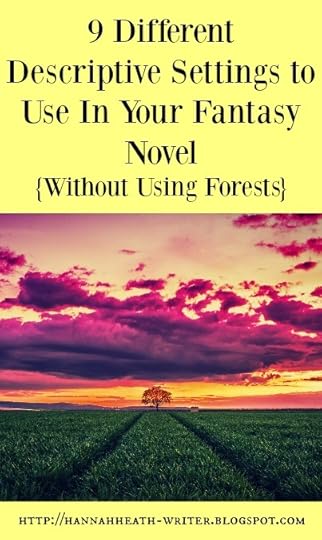 But what about tundras, guys? Or deserts? Or meadows? Or beaches or prairies, wetlands, glaciers, jungles, rice terraces, vales? What about those? Why don't those ever make it into books?
But what about tundras, guys? Or deserts? Or meadows? Or beaches or prairies, wetlands, glaciers, jungles, rice terraces, vales? What about those? Why don't those ever make it into books?
Stop the descriptive setting discrimination! Kill your forestcentricity. If you find yourself in the middle of building a fantasy world, stop and think about what you want to world to look like. Do you want it to be one big mess of forests, with the occasional mountain and river? Or do you want it to be a developed world with interesting terrains for your character to traverse?
If you said yes to the latter, here are some interesting and underused settings to use in your fantasy novel:
1. KarstsA karst is a landscape formed from the erosion of limestone (or other soluble stone), producing underground rivers, towers, caves, and sinkholes. They're quite beautiful, and can exist both inland and right on (or in) an ocean or lake:
 They can be dangerous, as sometimes the ground can be eroding right beneath you and you won't even know it. People fall through the ground or get their houses sucked into a massive rabbit hole. On the upside, they're great for spelunking. I'm sure Lucius Fox could set you up.
They can be dangerous, as sometimes the ground can be eroding right beneath you and you won't even know it. People fall through the ground or get their houses sucked into a massive rabbit hole. On the upside, they're great for spelunking. I'm sure Lucius Fox could set you up.
2. Cold DesertsWe all know about sandy, windy, hot deserts. But what about cold deserts? Technically, a desert isn't just a dry, hot place. It's defined as a barren area of land with harsh living conditions and very little precipitation. That's right, folks. Antarctica is a desert. That being said, cold deserts aren't necessarily just miles and miles of ice and snow. They can have sturdy shrubs, wildflowers, and lichen, among other things. Take a look:

3. Tropical RainforestsI'm always surprised at how anything tropics-related never make it into fantasy novels. I think it has to do with the fact that many fantasy books are eurocentric, a topic that A.Z. Anthony wrote about here (don't forget to follow his blog while you're over there. It's great). But, honestly, tropical rainforests are beautiful. I'm not including pictures because there were too many gorgeous ones and I couldn't decide which to put in. Also, I'm pretty sure we've all heard of tropical rainforests. If not, go google it.
4. Salt FlatsLarge areas of flat land covered in salt, this is one of the parts of our world that looks like it might belong on another planet: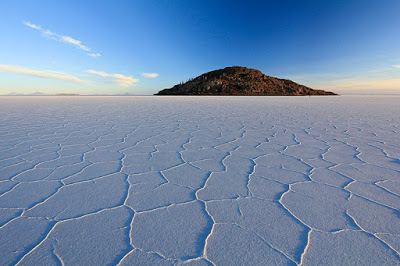 Think of the economical impact this could have in a fictional world. Forget the kingdom with the jewel mines. Think how powerful a king would be if he monopolized the largest salt flats in the world. Salt could become a type of currency. Pretty interesting, right?
Think of the economical impact this could have in a fictional world. Forget the kingdom with the jewel mines. Think how powerful a king would be if he monopolized the largest salt flats in the world. Salt could become a type of currency. Pretty interesting, right?
5. WetlandsGenerally, these show up in books as massive bogs full of dead people and flies that like to eat hobbit. While they can be dangerous, they can also be beautiful.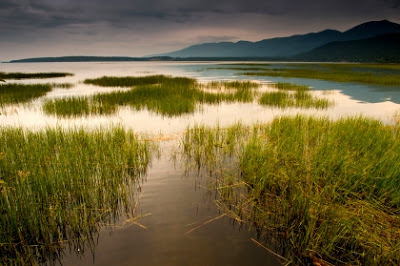 In a fictional world, a wetland could be a very prosperous area where special foods are grown. But sure, they could also be the place where all your exiles are cast into.
In a fictional world, a wetland could be a very prosperous area where special foods are grown. But sure, they could also be the place where all your exiles are cast into.
6. ArchipelagosThis, to me, was one of my favorite parts of The Wizards of Earthsea by Ursula K. Le Guin. Wizards running around islands and sailing boats? Yes, please! Not only are archipelagos beautiful, but they have a vast array of interesting creatures: fish, sharks, corals, sea stars, gulls. It's also worth noting that some peoples prefer to live near an archipelago, but not actually on them. Which means they live in boats or houses anchored off shore. Think of the possibilities:
 If you have time and are searching for writing inspiration, look up the Bajau Laut. They're actual sea nomads. It's amazing.
If you have time and are searching for writing inspiration, look up the Bajau Laut. They're actual sea nomads. It's amazing.
7. TundrasA region where the sub soil is always frozen or semi-frozen. There are no trees and, because of how windy tundras generally are, all of the plants grow very low to the ground.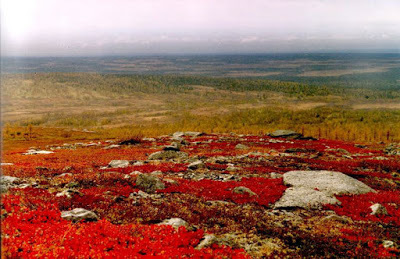 The tundra that I've been to (Glacier National Park in Montana) had beautiful little flowers all over the place, along with very short grass. And marmots. Don't forget about the marmots.
The tundra that I've been to (Glacier National Park in Montana) had beautiful little flowers all over the place, along with very short grass. And marmots. Don't forget about the marmots.
8. Mesas, Buttes, Hoodoos, and SpiresI don't know exactly what category these fall into. What? I only pretend to know everything. But, regardless of what geological subset they belong to, these are amazing. They're stunning soft rock formations carved out by wind or water, and can often be vibrant reds. Utah has some amazing ones that I've seen in person, but they can be found all over the world.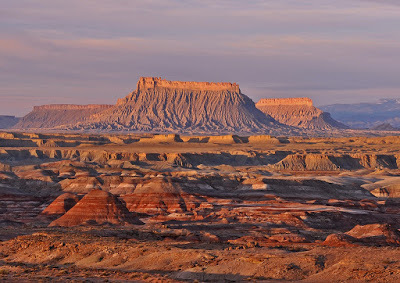
 Look up Zion National Park, specifically Angels Landing and The Narrows. That place is possibly the most gorgeous place I've been to date. I can't begin to explain to you how many story ideas it holds. So go look at pictures...or, if possible, visit it.
Look up Zion National Park, specifically Angels Landing and The Narrows. That place is possibly the most gorgeous place I've been to date. I can't begin to explain to you how many story ideas it holds. So go look at pictures...or, if possible, visit it.
9. MangrovesThese are really, really cool. It's a tidal habitat comprised of mangrove trees, which are trees that have roots both above and below ground, forming dense thickets.
 Not only could they make interesting houses, but I imagine they'd be a good way to drown people: stick 'em beneath the roots and wait for the tide to rise. What? I'm a writer. It's my job to think of stuff like that. Also, this is my way of making people think twice before leaving me angry comments. Just kidding.
Not only could they make interesting houses, but I imagine they'd be a good way to drown people: stick 'em beneath the roots and wait for the tide to rise. What? I'm a writer. It's my job to think of stuff like that. Also, this is my way of making people think twice before leaving me angry comments. Just kidding.
There are many, many other beautiful places to draw from. Steppes, dunes, mud flats, lava domes, glaciers, vales, many different kinds of mountains, deltas. Look them up.
My point isn't that you can't have forests in your fantasy novels. However, you should take some time to think about the world around you. It's vast and gorgeous and complex in so many different ways. Don't you want that reflected in your fantasy world? A unique descriptive setting is a great way to do this.
What do you think? Of all the settings listed above, which was your favorite? Which of them do you have in your book or will probably put in your book? I'd love to hear your thoughts!
Related items: 8 Tips to Improve Your Descriptive Writing7 Tips for Choosing Your Character's Appearance
Enjoy this post? Take a look around. If you like what you see, don't forget to subscribe by email for a new post every Friday!SaveSave
SaveSaveSaveSave
Incidentally, these forests are generally made up of only trees and, if the writer is feeling really creative, or wants to scrape up their character a bit, this large group of trees may also have "bramble."
Occasionally you get a mountain or two, generally some kind of rebel base with treacherous paths. And maybe a forest at the base. Because forests are the lifeblood of fantasy novels.
 But what about tundras, guys? Or deserts? Or meadows? Or beaches or prairies, wetlands, glaciers, jungles, rice terraces, vales? What about those? Why don't those ever make it into books?
But what about tundras, guys? Or deserts? Or meadows? Or beaches or prairies, wetlands, glaciers, jungles, rice terraces, vales? What about those? Why don't those ever make it into books?Stop the descriptive setting discrimination! Kill your forestcentricity. If you find yourself in the middle of building a fantasy world, stop and think about what you want to world to look like. Do you want it to be one big mess of forests, with the occasional mountain and river? Or do you want it to be a developed world with interesting terrains for your character to traverse?
If you said yes to the latter, here are some interesting and underused settings to use in your fantasy novel:
1. KarstsA karst is a landscape formed from the erosion of limestone (or other soluble stone), producing underground rivers, towers, caves, and sinkholes. They're quite beautiful, and can exist both inland and right on (or in) an ocean or lake:

 They can be dangerous, as sometimes the ground can be eroding right beneath you and you won't even know it. People fall through the ground or get their houses sucked into a massive rabbit hole. On the upside, they're great for spelunking. I'm sure Lucius Fox could set you up.
They can be dangerous, as sometimes the ground can be eroding right beneath you and you won't even know it. People fall through the ground or get their houses sucked into a massive rabbit hole. On the upside, they're great for spelunking. I'm sure Lucius Fox could set you up. 2. Cold DesertsWe all know about sandy, windy, hot deserts. But what about cold deserts? Technically, a desert isn't just a dry, hot place. It's defined as a barren area of land with harsh living conditions and very little precipitation. That's right, folks. Antarctica is a desert. That being said, cold deserts aren't necessarily just miles and miles of ice and snow. They can have sturdy shrubs, wildflowers, and lichen, among other things. Take a look:


3. Tropical RainforestsI'm always surprised at how anything tropics-related never make it into fantasy novels. I think it has to do with the fact that many fantasy books are eurocentric, a topic that A.Z. Anthony wrote about here (don't forget to follow his blog while you're over there. It's great). But, honestly, tropical rainforests are beautiful. I'm not including pictures because there were too many gorgeous ones and I couldn't decide which to put in. Also, I'm pretty sure we've all heard of tropical rainforests. If not, go google it.
4. Salt FlatsLarge areas of flat land covered in salt, this is one of the parts of our world that looks like it might belong on another planet:
 Think of the economical impact this could have in a fictional world. Forget the kingdom with the jewel mines. Think how powerful a king would be if he monopolized the largest salt flats in the world. Salt could become a type of currency. Pretty interesting, right?
Think of the economical impact this could have in a fictional world. Forget the kingdom with the jewel mines. Think how powerful a king would be if he monopolized the largest salt flats in the world. Salt could become a type of currency. Pretty interesting, right? 5. WetlandsGenerally, these show up in books as massive bogs full of dead people and flies that like to eat hobbit. While they can be dangerous, they can also be beautiful.
 In a fictional world, a wetland could be a very prosperous area where special foods are grown. But sure, they could also be the place where all your exiles are cast into.
In a fictional world, a wetland could be a very prosperous area where special foods are grown. But sure, they could also be the place where all your exiles are cast into. 6. ArchipelagosThis, to me, was one of my favorite parts of The Wizards of Earthsea by Ursula K. Le Guin. Wizards running around islands and sailing boats? Yes, please! Not only are archipelagos beautiful, but they have a vast array of interesting creatures: fish, sharks, corals, sea stars, gulls. It's also worth noting that some peoples prefer to live near an archipelago, but not actually on them. Which means they live in boats or houses anchored off shore. Think of the possibilities:

 If you have time and are searching for writing inspiration, look up the Bajau Laut. They're actual sea nomads. It's amazing.
If you have time and are searching for writing inspiration, look up the Bajau Laut. They're actual sea nomads. It's amazing. 7. TundrasA region where the sub soil is always frozen or semi-frozen. There are no trees and, because of how windy tundras generally are, all of the plants grow very low to the ground.
 The tundra that I've been to (Glacier National Park in Montana) had beautiful little flowers all over the place, along with very short grass. And marmots. Don't forget about the marmots.
The tundra that I've been to (Glacier National Park in Montana) had beautiful little flowers all over the place, along with very short grass. And marmots. Don't forget about the marmots. 8. Mesas, Buttes, Hoodoos, and SpiresI don't know exactly what category these fall into. What? I only pretend to know everything. But, regardless of what geological subset they belong to, these are amazing. They're stunning soft rock formations carved out by wind or water, and can often be vibrant reds. Utah has some amazing ones that I've seen in person, but they can be found all over the world.

 Look up Zion National Park, specifically Angels Landing and The Narrows. That place is possibly the most gorgeous place I've been to date. I can't begin to explain to you how many story ideas it holds. So go look at pictures...or, if possible, visit it.
Look up Zion National Park, specifically Angels Landing and The Narrows. That place is possibly the most gorgeous place I've been to date. I can't begin to explain to you how many story ideas it holds. So go look at pictures...or, if possible, visit it. 9. MangrovesThese are really, really cool. It's a tidal habitat comprised of mangrove trees, which are trees that have roots both above and below ground, forming dense thickets.

 Not only could they make interesting houses, but I imagine they'd be a good way to drown people: stick 'em beneath the roots and wait for the tide to rise. What? I'm a writer. It's my job to think of stuff like that. Also, this is my way of making people think twice before leaving me angry comments. Just kidding.
Not only could they make interesting houses, but I imagine they'd be a good way to drown people: stick 'em beneath the roots and wait for the tide to rise. What? I'm a writer. It's my job to think of stuff like that. Also, this is my way of making people think twice before leaving me angry comments. Just kidding. There are many, many other beautiful places to draw from. Steppes, dunes, mud flats, lava domes, glaciers, vales, many different kinds of mountains, deltas. Look them up.
My point isn't that you can't have forests in your fantasy novels. However, you should take some time to think about the world around you. It's vast and gorgeous and complex in so many different ways. Don't you want that reflected in your fantasy world? A unique descriptive setting is a great way to do this.
What do you think? Of all the settings listed above, which was your favorite? Which of them do you have in your book or will probably put in your book? I'd love to hear your thoughts!
Related items: 8 Tips to Improve Your Descriptive Writing7 Tips for Choosing Your Character's Appearance
Enjoy this post? Take a look around. If you like what you see, don't forget to subscribe by email for a new post every Friday!SaveSave
SaveSaveSaveSave

Published on November 11, 2016 06:30
November 4, 2016
Why Writers Should Strive to be More Like Batman
Every writer has somebody who has inspired them to write. Often they're others authors: J.K. Rowling, C.S. Lewis, J.R.R. Tolkien...and all the other great writers who all seem to have initials in their names. We strive to be like them, to study their methods, draw strength from their journeys.
Which is all well and admirable. But you know who we should really be trying to be more like in our writing careers?
Batman.
You think I'm joking? I'm not. I'm being dead serious. Or at least as serious as I can be when blogging. Which ranges from about 42% serious to 9 and 3/4 out of 10.
But back to Batman. Why should we be more like Batman? What parts of his personality should writers work towards? Let me tell you: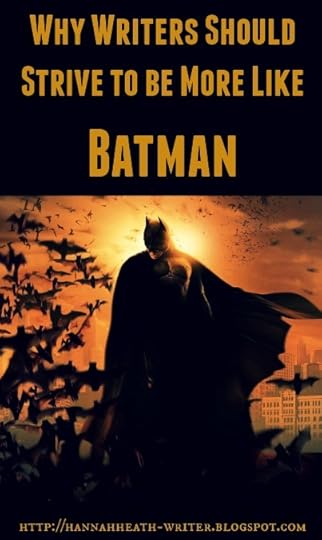 Have Batman-level self-controlPut that chocolate down and listen to what I'm saying. Have self-control. Discipline yourself and your writing. If Batman can spend his life fighting insane criminals without breaking his one rule, then you can get off of Netflix and write that story of yours. If Bruce Wayne can decide to dedicate his nights to dressing up like a bat and cleaning up Gotham, you can dedicate half an hour out of your day to doing some writing. Cosplaying as a scary animal is optional. Not wearing hockey pants is mandatory.
Have Batman-level self-controlPut that chocolate down and listen to what I'm saying. Have self-control. Discipline yourself and your writing. If Batman can spend his life fighting insane criminals without breaking his one rule, then you can get off of Netflix and write that story of yours. If Bruce Wayne can decide to dedicate his nights to dressing up like a bat and cleaning up Gotham, you can dedicate half an hour out of your day to doing some writing. Cosplaying as a scary animal is optional. Not wearing hockey pants is mandatory.
Turn everything to your advantage You have an hour long commute to work? Bring a tape recorder and outline your next book. Your internet is down for the week? Take the time to go outside and gain inspiration from nature. You have a chronic disease that makes it hard to write? Use it as fuel for a story. Your kids won't leave you alone? Put them to work building a batcave. Every problem you have is something you can use. Take advantage. If something is standing in the way of your writing, you simply walk up behind it and stab it in the heart (If you didn't read that in Liam Neeson's voice, you're reading this wrong). Plan for each problem that's blocking you from writing and find a way to work around it. Your plans should have plans. In fact, you should have a plan for when there is no plan:
Have the "Because I'm Batman!" mentalitySo you're having writers block. Or you think your writing couldn't ever possibly get published because you don't have the talent or the time or the energy. You're not about to let that stop you, are you? No. Do you know why? Because you're Batman! Errr. Wait. Because you're...you. You are the only one who can write this story (except for Batman...I bet he has your novel stuffed away in his utility belt somewhere). You may not have the words now, but keep at it and you will. You may not be published now, but keep at it and you will. You may not have a Batmobile now, but keep at it and you will. Why? Because you're you. You are awesome and you are determined and you will let nothing stand in your way. That's all the logic you need. You can make it through the rest of your problems using a utility belt and sheer pigheaded self-confidence: [image error] This is called the "Because I'm Batman!" mentality, and it has served me well. Or, more accurately, the "Because I'm [insert your name here]!" mentality. Use it. It works.
Be the writer the world deservesI've heard from so many writer who think that they'll never get published because their writing isn't mainstream. They think they have to follow the trend or get left behind. Don't do this. Don't be that writer. Be the writer the world deserves, even if it's not the one they think they need right now. So write that book of yours without the sexy teenage love triangle. Pitch your novel that centers around deep, philosophical thoughts. Don't be afraid to be a writer with morals or a writer who puts meaning behind their words. It doesn't matter if people don't understand what you're doing. Besides, how bad can this possibly go? It's not as if the GCPD are going to come after you. So don't let the world define what kind of a writer you are. Just be the one you know you should be. Speaking of which...
Be willing to work long and hardWriting a good story takes a long time. It can be lonely. It can be hard. It often goes without recognition. In fact, it's a lot like being a vigilante. Except it doesn't generally involve archnemeses or near-death encounters...unless we're talking about that time when your computer crashed and you ran out of caffeine. Anyway, stop complaining about your writer's block on twitter. Did you ever hear Batman complain? No. So follow his lead and get down to work.
Appreciate your butler...er...readersIf you are fortunate enough to have an awesome British butler, then appreciate to him, too. Just as Batman would be nothing without Alfred, you are nothing without your readers. Remember it. Thank them, treat them well, and keep any green-haired psychos with crowbars away from them.
The best thing about Batman is that he never gives up. He fights an uphill battle for his entire life on several different fronts: fixing Gotham, keeping his friends alive, maintaining his sanity, sticking to his one rule. He goes through every imaginable ordeal and just keeps coming back. He survived multiple deaths of loved ones, that one comic where he became Zebra Batman...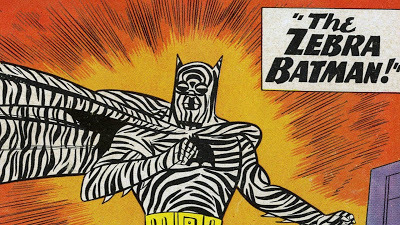 Just...don't ask.kept fighting when he had to wear an entire exoskeleton just to walk...
Just...don't ask.kept fighting when he had to wear an entire exoskeleton just to walk...
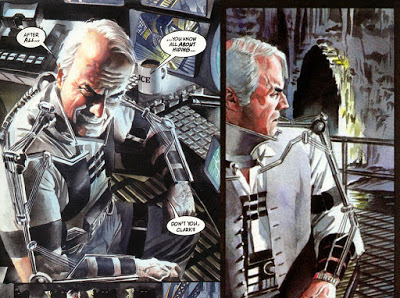 From Kingdom Come by Mark Waidbroke his back multiple times to climb out of the Pit, and was even able to get rid of that bomb back in 1966. And that's just to name a few.
From Kingdom Come by Mark Waidbroke his back multiple times to climb out of the Pit, and was even able to get rid of that bomb back in 1966. And that's just to name a few.
So maybe your story will get rejected by a ton of publishers. Maybe you'll get a few 1-star reviews. Maybe you really aren't any good at any of this writing stuff. But you'll never know if you don't keep trying, will you? So, when you fall, just learn to pick yourself back up again, shake your fist at the sky, scream "I'm [insert your name here]!" in a gravelly voice, and get back to work.
So what do you think? Are you willing to work hard to become a better, stronger, smarter, more Batman-y writer? That's what I'm doing. Who's with me?
Don't forget to tell me about your favorite Batman moment in the comment section below!
Related articles:
Why There's No Such Thing As "Just A Story"
5 Steps to Fighting Off Writer's Insecurity
10 Things Nobody Tells You About Being A Writer...Until It's Too Late
Enjoy this post? Take a look around. If you like what you see, don't forget to subscribe by email for a new post every Friday!SaveSaveSaveSave
SaveSave
Which is all well and admirable. But you know who we should really be trying to be more like in our writing careers?
Batman.
You think I'm joking? I'm not. I'm being dead serious. Or at least as serious as I can be when blogging. Which ranges from about 42% serious to 9 and 3/4 out of 10.
But back to Batman. Why should we be more like Batman? What parts of his personality should writers work towards? Let me tell you:
 Have Batman-level self-controlPut that chocolate down and listen to what I'm saying. Have self-control. Discipline yourself and your writing. If Batman can spend his life fighting insane criminals without breaking his one rule, then you can get off of Netflix and write that story of yours. If Bruce Wayne can decide to dedicate his nights to dressing up like a bat and cleaning up Gotham, you can dedicate half an hour out of your day to doing some writing. Cosplaying as a scary animal is optional. Not wearing hockey pants is mandatory.
Have Batman-level self-controlPut that chocolate down and listen to what I'm saying. Have self-control. Discipline yourself and your writing. If Batman can spend his life fighting insane criminals without breaking his one rule, then you can get off of Netflix and write that story of yours. If Bruce Wayne can decide to dedicate his nights to dressing up like a bat and cleaning up Gotham, you can dedicate half an hour out of your day to doing some writing. Cosplaying as a scary animal is optional. Not wearing hockey pants is mandatory. Turn everything to your advantage You have an hour long commute to work? Bring a tape recorder and outline your next book. Your internet is down for the week? Take the time to go outside and gain inspiration from nature. You have a chronic disease that makes it hard to write? Use it as fuel for a story. Your kids won't leave you alone? Put them to work building a batcave. Every problem you have is something you can use. Take advantage. If something is standing in the way of your writing, you simply walk up behind it and stab it in the heart (If you didn't read that in Liam Neeson's voice, you're reading this wrong). Plan for each problem that's blocking you from writing and find a way to work around it. Your plans should have plans. In fact, you should have a plan for when there is no plan:

Have the "Because I'm Batman!" mentalitySo you're having writers block. Or you think your writing couldn't ever possibly get published because you don't have the talent or the time or the energy. You're not about to let that stop you, are you? No. Do you know why? Because you're Batman! Errr. Wait. Because you're...you. You are the only one who can write this story (except for Batman...I bet he has your novel stuffed away in his utility belt somewhere). You may not have the words now, but keep at it and you will. You may not be published now, but keep at it and you will. You may not have a Batmobile now, but keep at it and you will. Why? Because you're you. You are awesome and you are determined and you will let nothing stand in your way. That's all the logic you need. You can make it through the rest of your problems using a utility belt and sheer pigheaded self-confidence: [image error] This is called the "Because I'm Batman!" mentality, and it has served me well. Or, more accurately, the "Because I'm [insert your name here]!" mentality. Use it. It works.
Be the writer the world deservesI've heard from so many writer who think that they'll never get published because their writing isn't mainstream. They think they have to follow the trend or get left behind. Don't do this. Don't be that writer. Be the writer the world deserves, even if it's not the one they think they need right now. So write that book of yours without the sexy teenage love triangle. Pitch your novel that centers around deep, philosophical thoughts. Don't be afraid to be a writer with morals or a writer who puts meaning behind their words. It doesn't matter if people don't understand what you're doing. Besides, how bad can this possibly go? It's not as if the GCPD are going to come after you. So don't let the world define what kind of a writer you are. Just be the one you know you should be. Speaking of which...
Be willing to work long and hardWriting a good story takes a long time. It can be lonely. It can be hard. It often goes without recognition. In fact, it's a lot like being a vigilante. Except it doesn't generally involve archnemeses or near-death encounters...unless we're talking about that time when your computer crashed and you ran out of caffeine. Anyway, stop complaining about your writer's block on twitter. Did you ever hear Batman complain? No. So follow his lead and get down to work.
Appreciate your butler...er...readersIf you are fortunate enough to have an awesome British butler, then appreciate to him, too. Just as Batman would be nothing without Alfred, you are nothing without your readers. Remember it. Thank them, treat them well, and keep any green-haired psychos with crowbars away from them.
The best thing about Batman is that he never gives up. He fights an uphill battle for his entire life on several different fronts: fixing Gotham, keeping his friends alive, maintaining his sanity, sticking to his one rule. He goes through every imaginable ordeal and just keeps coming back. He survived multiple deaths of loved ones, that one comic where he became Zebra Batman...
 Just...don't ask.kept fighting when he had to wear an entire exoskeleton just to walk...
Just...don't ask.kept fighting when he had to wear an entire exoskeleton just to walk...
 From Kingdom Come by Mark Waidbroke his back multiple times to climb out of the Pit, and was even able to get rid of that bomb back in 1966. And that's just to name a few.
From Kingdom Come by Mark Waidbroke his back multiple times to climb out of the Pit, and was even able to get rid of that bomb back in 1966. And that's just to name a few.So maybe your story will get rejected by a ton of publishers. Maybe you'll get a few 1-star reviews. Maybe you really aren't any good at any of this writing stuff. But you'll never know if you don't keep trying, will you? So, when you fall, just learn to pick yourself back up again, shake your fist at the sky, scream "I'm [insert your name here]!" in a gravelly voice, and get back to work.
So what do you think? Are you willing to work hard to become a better, stronger, smarter, more Batman-y writer? That's what I'm doing. Who's with me?
Don't forget to tell me about your favorite Batman moment in the comment section below!
Related articles:
Why There's No Such Thing As "Just A Story"
5 Steps to Fighting Off Writer's Insecurity
10 Things Nobody Tells You About Being A Writer...Until It's Too Late
Enjoy this post? Take a look around. If you like what you see, don't forget to subscribe by email for a new post every Friday!SaveSaveSaveSave
SaveSave

Published on November 04, 2016 06:59
October 28, 2016
November Cakes Inspired by Maggie Stiefvater's The Scorpio Races
Have you ever had the feeling that you're being followed? I have. All of the time.
Specifically, I always feel that I'm being followed by books. I'll go months with a single book stalking me. It shows up in my Goodreads feed, in ads in the sidebars of all the website I visit, in the window of my local Barnes and Noble. People who follow me tweet me about it, and people I follow review it. Everywhere I turn I see the book and I know there is no escape.
My most most recent experience with this was The Scorpio Races by Maggie Stiefvater. It would not stop following me, so I finally took the time to look it up. I found out it was about the racing of magical, ferocious, deadly-fast water horses and I knew we were destined to be.
The Scorpio Races. It happens ever November. The men of Thisby gallop their water horses along the beach, trying to make it across the finish line without losing control and being drowned by their steeds.
Sean Kendrick, a boy of 19, has won the races four years on a water horse that is owned by another but can only be controlled by him. He speaks little and keeps his thoughts close. He has one goal and means to focus all he has on attaining it: One day he means to own the horse that he has won so many races on. This year may be his chance.
Puck Connolly has no interest in water horses or the Scorpio Races: If it weren’t for those two things, her parents might still be alive. But fate doesn’t seem to care about her opinion: Either she rides in and wins the Scorpio Races or she loses their house, her horse, and at least one of her brothers.
So she enters the competition and becomes the first girl to ride in the Races….And the only person to ride it on a normal horse.
Some riders will survive. Some riders will die. Both Puck and Sean are aiming far higher than that. They mean to win, but only one of them can seize the title.
This is one of the more brilliant novels I've read this year. Maggie Stiefvater's writing made me stare at her creation and think, "THIS. This is how writing should be." Strong, beautiful, thought-provoking.
Her character development is amazing, the sibling relationships portrayed in an accurate and sweet way, the world-building perfect, the man-eating water horses both fascinating and frightening, and the prose intensely energetic and vivid. If you want to read my full review of this novel (which you really should, since I have a lot more to say about this book, but can't fit it all here), then you can check out my review on Constant Collectible, a geek website I write for.
You know what else I really loved about this book? The food. More precisely: The November cakes.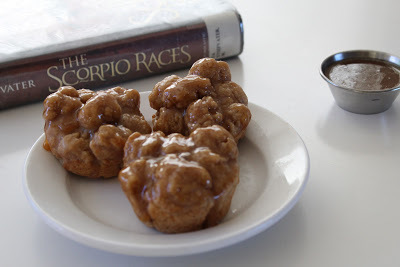 Described as small, warm cakes dripping with honey, every time they were mentioned I ended up getting hungry. If you've read this book, you know exactly what I'm talking about.
Described as small, warm cakes dripping with honey, every time they were mentioned I ended up getting hungry. If you've read this book, you know exactly what I'm talking about.
I set out to make these delicious-sounding November cakes and discovered that the author herself actually So here's me making Puck proud by my rebellious ways and making my version of November cakes:
Ingredients for the cake: 2 cups of flour1/4 cup of brown sugar1 tablespoon of baking powder 1/2 teaspoon of salt1 teaspoon of cinnamon. Cinnamon goes in everything. I know I say this every time I do a recipe, but seriously. Cinnamon. Use it. I'm just going to keep repeating this until I brainwash you all into my love of this amazing spice. 1/8 teaspoon of nutmeg5 tablespoons of unsalted butter3/4 cup of rice milk (or regular milk, if you drink that stuff. I'm not judging, but...EW.)Zest from one medium orange 1 teaspoon of vanilla. Say hello to my little friend: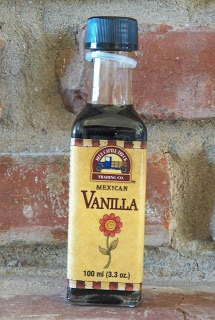 I recently discovered Mexican vanilla and have been putting it in everything. It's amazing. Ingredients for filling: 5 tablespoons of soft or melted butter1 tablespoon of orange juiceIngredients for glaze: 5 tablespoons of butter. As you can see from the frequency of butter in this recipe, I've had to turn off the Nutrition major part of my brain while making these cakes. But it's worth it. 1/2 cup of honey1/4 cup brown sugar1/4 teaspoon of vanillapinch of salt1. In a medium bowl, mix together the flour, brown sugar, baking powder, salt, cinnamon, and nutmeg. Cut in 5 tablespoons of butter into the flour mixture. You can use a fancy pastry cutter or two forks. Or you can stab the mixture repeatedly with a knife while muttering, "Dieee! Dieee!" ANYWAY, using your chosen method, cut the butter into the flour mixture until the butter pieces are the size of peas.
I recently discovered Mexican vanilla and have been putting it in everything. It's amazing. Ingredients for filling: 5 tablespoons of soft or melted butter1 tablespoon of orange juiceIngredients for glaze: 5 tablespoons of butter. As you can see from the frequency of butter in this recipe, I've had to turn off the Nutrition major part of my brain while making these cakes. But it's worth it. 1/2 cup of honey1/4 cup brown sugar1/4 teaspoon of vanillapinch of salt1. In a medium bowl, mix together the flour, brown sugar, baking powder, salt, cinnamon, and nutmeg. Cut in 5 tablespoons of butter into the flour mixture. You can use a fancy pastry cutter or two forks. Or you can stab the mixture repeatedly with a knife while muttering, "Dieee! Dieee!" ANYWAY, using your chosen method, cut the butter into the flour mixture until the butter pieces are the size of peas.
2. In a measuring cup, mix together the rice milk, vanilla, and orange zest. Pour into the flour mixture and stir until the flour begins to hold together.
3. On a floured surface (as in, a surface that is not your floor...just to be clear), knead this dough out a few times. Let it sit for a few minutes while you butter the inside of a muffin tin. Then tear off small pieces of the dough, roll them into balls, and place them in the tins. Only fill each tin up about half way.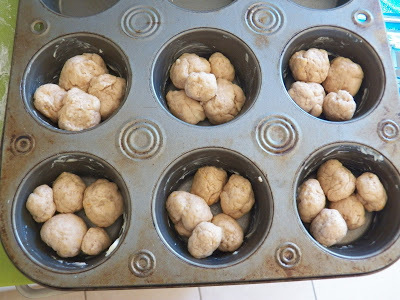
4. In a small bowl, mix together the soft butter and orange juice.
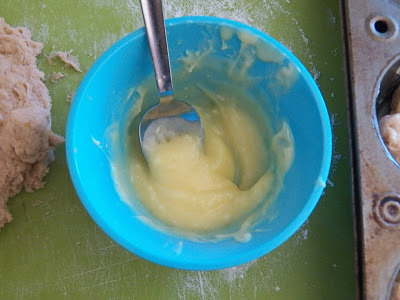 Put a little bit in each muffin tin, spreading it evenly across the dough.
Put a little bit in each muffin tin, spreading it evenly across the dough.
5. Fill the muffin tins up with the remainder of the dough. Place in a 350 degree oven and bake for 10 minutes or until cooked through (if a knife poked into it's center comes out clean, it's done).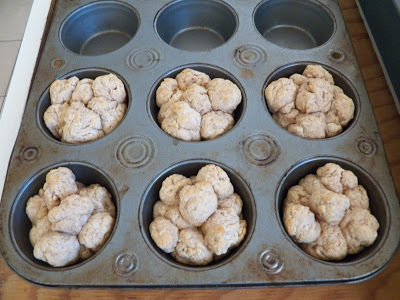 Note: The recipe actually makes 12 cakes, not 6. I only used half of the dough here just in case my oven went rogue and burned everything up, as it is fond of doing.6. While the muffins are cooking, combine all ingredients for the glaze in a medium saucepan. Place on high while waiting for the sugar to dissolve, then lower to medium heat, stirring constantly. Once it starts to boil, lower the heat to a simmer for a minute or so before taking it off the heat. It should be a sticky glaze that will coat the back of a spoon.
Note: The recipe actually makes 12 cakes, not 6. I only used half of the dough here just in case my oven went rogue and burned everything up, as it is fond of doing.6. While the muffins are cooking, combine all ingredients for the glaze in a medium saucepan. Place on high while waiting for the sugar to dissolve, then lower to medium heat, stirring constantly. Once it starts to boil, lower the heat to a simmer for a minute or so before taking it off the heat. It should be a sticky glaze that will coat the back of a spoon.
7. Once the cakes have cooled enough to handle, dip them in the glaze and let rest for a few minutes to allow the glaze to set.
You can eat them by themselves or with buttered and salted tea. Which sounds gross and is what the antagonist drinks, so maybe just do regular tea.
This is the kind of yummy, sticky food you eat on a rainy weekend while curled up with a good book...preferably The Scorpio Races.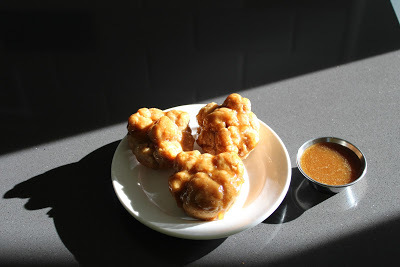 I cannot recommend The Scorpio Races enough. Read this book for the amazing prose, the simple yet breathtaking plot, the great characterization, and the heart-warming sibling relationships. The Scorpio Races also gets points for being a YA novel with a romance that didn't make me want to claw my eyes out. The only way this book could be better is if Batman was in it. But not everything can be perfect, I suppose.
I cannot recommend The Scorpio Races enough. Read this book for the amazing prose, the simple yet breathtaking plot, the great characterization, and the heart-warming sibling relationships. The Scorpio Races also gets points for being a YA novel with a romance that didn't make me want to claw my eyes out. The only way this book could be better is if Batman was in it. But not everything can be perfect, I suppose.
Have you read The Scorpio Races ? Tell me about your favorite aspect! And, if you're a fan of Stiefvater, please let me know which of her books I should read next.
Related articles:
Rosa Hubermann's Pea Soup Inspired by The Book Thief
German Potato Salad Inspired by Andy Weir's the Martian
Roasted Vegetable Sandwich inspired by Christie Golden's Dark Disciple
Enjoy this post? Take a look around! If you like what you see, subscribe by email for a new post every Friday!
Some links are Amazon Affiliate. Thank you for your support!
SaveSave
Specifically, I always feel that I'm being followed by books. I'll go months with a single book stalking me. It shows up in my Goodreads feed, in ads in the sidebars of all the website I visit, in the window of my local Barnes and Noble. People who follow me tweet me about it, and people I follow review it. Everywhere I turn I see the book and I know there is no escape.
My most most recent experience with this was The Scorpio Races by Maggie Stiefvater. It would not stop following me, so I finally took the time to look it up. I found out it was about the racing of magical, ferocious, deadly-fast water horses and I knew we were destined to be.
The Scorpio Races. It happens ever November. The men of Thisby gallop their water horses along the beach, trying to make it across the finish line without losing control and being drowned by their steeds.
Sean Kendrick, a boy of 19, has won the races four years on a water horse that is owned by another but can only be controlled by him. He speaks little and keeps his thoughts close. He has one goal and means to focus all he has on attaining it: One day he means to own the horse that he has won so many races on. This year may be his chance.
Puck Connolly has no interest in water horses or the Scorpio Races: If it weren’t for those two things, her parents might still be alive. But fate doesn’t seem to care about her opinion: Either she rides in and wins the Scorpio Races or she loses their house, her horse, and at least one of her brothers.
So she enters the competition and becomes the first girl to ride in the Races….And the only person to ride it on a normal horse.
Some riders will survive. Some riders will die. Both Puck and Sean are aiming far higher than that. They mean to win, but only one of them can seize the title.
This is one of the more brilliant novels I've read this year. Maggie Stiefvater's writing made me stare at her creation and think, "THIS. This is how writing should be." Strong, beautiful, thought-provoking.
Her character development is amazing, the sibling relationships portrayed in an accurate and sweet way, the world-building perfect, the man-eating water horses both fascinating and frightening, and the prose intensely energetic and vivid. If you want to read my full review of this novel (which you really should, since I have a lot more to say about this book, but can't fit it all here), then you can check out my review on Constant Collectible, a geek website I write for.
You know what else I really loved about this book? The food. More precisely: The November cakes.
 Described as small, warm cakes dripping with honey, every time they were mentioned I ended up getting hungry. If you've read this book, you know exactly what I'm talking about.
Described as small, warm cakes dripping with honey, every time they were mentioned I ended up getting hungry. If you've read this book, you know exactly what I'm talking about. I set out to make these delicious-sounding November cakes and discovered that the author herself actually So here's me making Puck proud by my rebellious ways and making my version of November cakes:

Ingredients for the cake: 2 cups of flour1/4 cup of brown sugar1 tablespoon of baking powder 1/2 teaspoon of salt1 teaspoon of cinnamon. Cinnamon goes in everything. I know I say this every time I do a recipe, but seriously. Cinnamon. Use it. I'm just going to keep repeating this until I brainwash you all into my love of this amazing spice. 1/8 teaspoon of nutmeg5 tablespoons of unsalted butter3/4 cup of rice milk (or regular milk, if you drink that stuff. I'm not judging, but...EW.)Zest from one medium orange 1 teaspoon of vanilla. Say hello to my little friend:
 I recently discovered Mexican vanilla and have been putting it in everything. It's amazing. Ingredients for filling: 5 tablespoons of soft or melted butter1 tablespoon of orange juiceIngredients for glaze: 5 tablespoons of butter. As you can see from the frequency of butter in this recipe, I've had to turn off the Nutrition major part of my brain while making these cakes. But it's worth it. 1/2 cup of honey1/4 cup brown sugar1/4 teaspoon of vanillapinch of salt1. In a medium bowl, mix together the flour, brown sugar, baking powder, salt, cinnamon, and nutmeg. Cut in 5 tablespoons of butter into the flour mixture. You can use a fancy pastry cutter or two forks. Or you can stab the mixture repeatedly with a knife while muttering, "Dieee! Dieee!" ANYWAY, using your chosen method, cut the butter into the flour mixture until the butter pieces are the size of peas.
I recently discovered Mexican vanilla and have been putting it in everything. It's amazing. Ingredients for filling: 5 tablespoons of soft or melted butter1 tablespoon of orange juiceIngredients for glaze: 5 tablespoons of butter. As you can see from the frequency of butter in this recipe, I've had to turn off the Nutrition major part of my brain while making these cakes. But it's worth it. 1/2 cup of honey1/4 cup brown sugar1/4 teaspoon of vanillapinch of salt1. In a medium bowl, mix together the flour, brown sugar, baking powder, salt, cinnamon, and nutmeg. Cut in 5 tablespoons of butter into the flour mixture. You can use a fancy pastry cutter or two forks. Or you can stab the mixture repeatedly with a knife while muttering, "Dieee! Dieee!" ANYWAY, using your chosen method, cut the butter into the flour mixture until the butter pieces are the size of peas.2. In a measuring cup, mix together the rice milk, vanilla, and orange zest. Pour into the flour mixture and stir until the flour begins to hold together.
3. On a floured surface (as in, a surface that is not your floor...just to be clear), knead this dough out a few times. Let it sit for a few minutes while you butter the inside of a muffin tin. Then tear off small pieces of the dough, roll them into balls, and place them in the tins. Only fill each tin up about half way.

4. In a small bowl, mix together the soft butter and orange juice.
 Put a little bit in each muffin tin, spreading it evenly across the dough.
Put a little bit in each muffin tin, spreading it evenly across the dough. 5. Fill the muffin tins up with the remainder of the dough. Place in a 350 degree oven and bake for 10 minutes or until cooked through (if a knife poked into it's center comes out clean, it's done).
 Note: The recipe actually makes 12 cakes, not 6. I only used half of the dough here just in case my oven went rogue and burned everything up, as it is fond of doing.6. While the muffins are cooking, combine all ingredients for the glaze in a medium saucepan. Place on high while waiting for the sugar to dissolve, then lower to medium heat, stirring constantly. Once it starts to boil, lower the heat to a simmer for a minute or so before taking it off the heat. It should be a sticky glaze that will coat the back of a spoon.
Note: The recipe actually makes 12 cakes, not 6. I only used half of the dough here just in case my oven went rogue and burned everything up, as it is fond of doing.6. While the muffins are cooking, combine all ingredients for the glaze in a medium saucepan. Place on high while waiting for the sugar to dissolve, then lower to medium heat, stirring constantly. Once it starts to boil, lower the heat to a simmer for a minute or so before taking it off the heat. It should be a sticky glaze that will coat the back of a spoon. 7. Once the cakes have cooled enough to handle, dip them in the glaze and let rest for a few minutes to allow the glaze to set.
You can eat them by themselves or with buttered and salted tea. Which sounds gross and is what the antagonist drinks, so maybe just do regular tea.
This is the kind of yummy, sticky food you eat on a rainy weekend while curled up with a good book...preferably The Scorpio Races.
 I cannot recommend The Scorpio Races enough. Read this book for the amazing prose, the simple yet breathtaking plot, the great characterization, and the heart-warming sibling relationships. The Scorpio Races also gets points for being a YA novel with a romance that didn't make me want to claw my eyes out. The only way this book could be better is if Batman was in it. But not everything can be perfect, I suppose.
I cannot recommend The Scorpio Races enough. Read this book for the amazing prose, the simple yet breathtaking plot, the great characterization, and the heart-warming sibling relationships. The Scorpio Races also gets points for being a YA novel with a romance that didn't make me want to claw my eyes out. The only way this book could be better is if Batman was in it. But not everything can be perfect, I suppose.Have you read The Scorpio Races ? Tell me about your favorite aspect! And, if you're a fan of Stiefvater, please let me know which of her books I should read next.
Related articles:
Rosa Hubermann's Pea Soup Inspired by The Book Thief
German Potato Salad Inspired by Andy Weir's the Martian
Roasted Vegetable Sandwich inspired by Christie Golden's Dark Disciple
Enjoy this post? Take a look around! If you like what you see, subscribe by email for a new post every Friday!
Some links are Amazon Affiliate. Thank you for your support!
SaveSave

Published on October 28, 2016 07:41
October 21, 2016
Writing Characters with Depression: What You're Doing Wrong
The curtains are blue. It's raining outside. My character's heart feels heavy with an indescribable something that apparently isn't too indescribable because I'll spend about a page talking about it. Everything appears in dull greys and heavy blacks. There are violins playing sorrowfully in the background.
Get it? Do you get it, guys? What, you didn't catch on? My character has depression. I guess I was being too subtle.
That's a problem most writers have when writing about depression. They're too subtle. It's not as if they're whacking their readers over the head with a 10 pound sack of sad. They probably should give it a shot. Maybe that would help clear books up of all of the terribly written depressed characters.
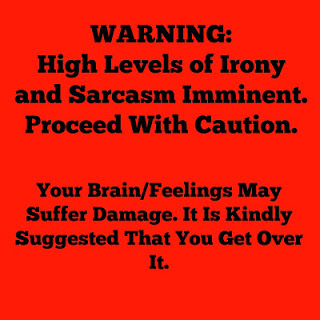 You know what makes me depressed? A badly written character. So, today, I'm focusing on a particular type of character: A badly written character with depression. Because they're all over the place, and your depressed character just might be adding to the problem.
You know what makes me depressed? A badly written character. So, today, I'm focusing on a particular type of character: A badly written character with depression. Because they're all over the place, and your depressed character just might be adding to the problem.
I'd give you advice, but you wouldn't listen. Nobody ever does.
Oh, who am I kidding? I'll give it anyway. Here we go:
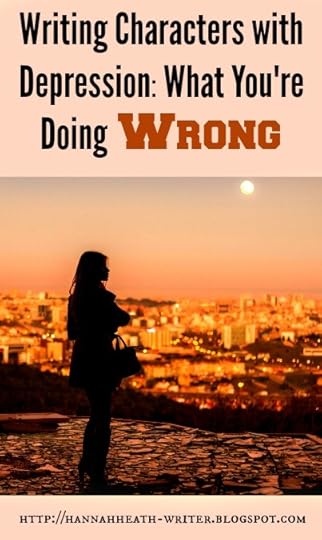 1. You think depression just means sadness. I don't know your name, so I'm just going to call you Bob. So: Sit down, Bob. I'm not happy, Bob. Not. Happy. And I don't mean "not happy," as in depressed. I mean, "not happy" because you are writing a depressed character and didn't take the time to look up what that actually means. Depressed people have more emotions than just sad. Depression is a mixture of dozens of emotions, which is why it's so hard to deal with. Depression can mean sadness, yes, but it can mean apathy, it can mean hopelessness, anger, anxiety, loneliness, numbness, negativity, fatigue, loss of appetite, emptiness, shame, having a loud voice in your head that screams at you, "You are unworthy!" Like everything with character development, struggles with depression should be layered. So don't just slap on a "sad" label and move on. Dig deeper. Do better.
1. You think depression just means sadness. I don't know your name, so I'm just going to call you Bob. So: Sit down, Bob. I'm not happy, Bob. Not. Happy. And I don't mean "not happy," as in depressed. I mean, "not happy" because you are writing a depressed character and didn't take the time to look up what that actually means. Depressed people have more emotions than just sad. Depression is a mixture of dozens of emotions, which is why it's so hard to deal with. Depression can mean sadness, yes, but it can mean apathy, it can mean hopelessness, anger, anxiety, loneliness, numbness, negativity, fatigue, loss of appetite, emptiness, shame, having a loud voice in your head that screams at you, "You are unworthy!" Like everything with character development, struggles with depression should be layered. So don't just slap on a "sad" label and move on. Dig deeper. Do better.
2. You're being too subtle. You need to paint it on thick. You're writing a depressed character, so why not make them super depressed all of the time? Depression is startlingly obvious and always recognizable, so reflect this in your books. It's very realistic and I'm sure it won't annoy your readers at all. It's not as if depression can be a subtle thing that lurks in the background. So why portray it as such? After all, that takes too much time and skill. So don't do it.
[image error]
3. You think depressed characters need to be part of a depressing storyline. When people ask you how your books with depressed character are going, you shouldn't answer: "Well, they're just fine. You know, a little dark, a little gloomy. And, as always, hey, full of dead people." No. NO. A depressed character doesn't need to be in the middle of a storyline where people are dying left and right or where the whole world is burning. I mean, if that's the plot line of your story, that's fine. But depressed characters are not exclusive to dark storylines or hard lives.
4. All of your depressed characters are introverts. I've noticed this a lot in both books and film. Depression is almost always portrayed as a disease that extroverts are somehow immune to. Extroverts can be depressed, it just may be less obvious. After all, extroverts are out and about, having to wear a mask to cover up the fact that they have a dementor following them around. So, if you are tackling depression in your novel, don't be afraid to give it to an extroverted character. It's a problem that needs to be written about.
5. You are romanticizing suicide. Really? How long have you been training to be a prat? There are so many books out there that make depression look...alluring? Special. Pretty. It's not. Don't write a book that makes depression out to look like some poetic journey about becoming one with the darkness. And do NOT romanticize depressed characters who considering committing...or do commit...suicide. There are no words to describe how damaging this is.
6. You forget that depressed people have interests and personalities. No, sitting around and thinking about death does not count as an interest or personality. Depressed people like things just like anybody else: They like to bake, play the violin, go hunting, paint a picture, build a hot rod, read a novel. Some depressed people are logical, some are sarcastic, some are sweet, some are gruff. Flesh out your character as a person first, then give them depression. Not only is this more realistic, but it will keep your depressed character from falling into the shallow, nobody-likes-you character zone populated by Bella Swan.
7. Your writing style is overly flowery. When writing from a depressed point of view, many writers have the tendency to wax poetic. Stop being so dramatic. Find the style that you are good at and use it. Don't feel the need to contemplate the meaning of life, the universe, and everything.
8. You didn't read up on other depressed characters. Books are full of amazingly written characters suffering from depression. They come in all genres with all different personalities and manifestations. Some of my favorite: Frodo from Lord of the Rings (read this great post on the topic), Arima Kousei from Your Lie in April, Eeyore from Winnie-the-Pooh, Charlie Brown, Marvin from The Hitchhiker's Guide to the Galaxy, Conor from A Monster Calls, Celia Foote from The Help, Gwystyl from The Prydain Chronicles. Read them. Study them. Learn from them.
9. You're using depression as an excuse. I get it. Depression is a very good excuse for a character who is constantly throwing a pity-party and being annoying. But it's not a good enough one. Everybody has problems. Get over it. Depression is not a free pass to allow your character to be mean, lazy, or generally annoying. Either show your character struggling to change or make it clear that their lack of change isn't healthy. Don't just excuse them with the, "Oh, depression" excuse. After all, their problems can't be as bad as Marvin's.
[image error] 10. Your character isn't awesome enough. You know what we need more of? Depressed characters kicking butt. Do you have any idea how awesome depressed people are? They have to fight their own minds on a regular basis, but they still keep going. Enough of the depressed characters who get dragged around by their non-depressed friends. Let's have more depressed characters who drag themselves around. Depression tells them: "You are in Hell, little man. And I am the devil." And they look back and say, "You're not the devil. You're practice." And then proceed to beat the crap out of depression. What? I love me my Batman references. But seriously, people who fight depression are amazing. So let's have more characters who get up every day because they're not about to let depression get the better of them. That, my friends, is a type of strength that fiction can use more of.
Honestly, writing characters with depression isn't that difficult. And no, you don't have to have depression yourself in order to write on this topic. You just have to take the time to get to know your character and what their particular brand of depression is. It takes time, but any character worth writing takes time.
Do you have any tips for writing characters with depression? If you're writing a depressed character or have a favorite fictional depressed character, please tell me about them in the comment section below!
Related articles:
Writing Teenaged Characters: What You're Doing Wrong
Writing Strong Female Characters: What You're Doing Wrong
Writing Awesome Male Characters: What You're Doing Wrong
Enjoy this post? Take a look around. If you like what you see, don't forget to subscribe by email for a new post every Friday!
Some links are Amazon Affiliate. Thank you for your support!
SaveSave
SaveSave
SaveSave
Get it? Do you get it, guys? What, you didn't catch on? My character has depression. I guess I was being too subtle.
That's a problem most writers have when writing about depression. They're too subtle. It's not as if they're whacking their readers over the head with a 10 pound sack of sad. They probably should give it a shot. Maybe that would help clear books up of all of the terribly written depressed characters.
 You know what makes me depressed? A badly written character. So, today, I'm focusing on a particular type of character: A badly written character with depression. Because they're all over the place, and your depressed character just might be adding to the problem.
You know what makes me depressed? A badly written character. So, today, I'm focusing on a particular type of character: A badly written character with depression. Because they're all over the place, and your depressed character just might be adding to the problem.I'd give you advice, but you wouldn't listen. Nobody ever does.
Oh, who am I kidding? I'll give it anyway. Here we go:
 1. You think depression just means sadness. I don't know your name, so I'm just going to call you Bob. So: Sit down, Bob. I'm not happy, Bob. Not. Happy. And I don't mean "not happy," as in depressed. I mean, "not happy" because you are writing a depressed character and didn't take the time to look up what that actually means. Depressed people have more emotions than just sad. Depression is a mixture of dozens of emotions, which is why it's so hard to deal with. Depression can mean sadness, yes, but it can mean apathy, it can mean hopelessness, anger, anxiety, loneliness, numbness, negativity, fatigue, loss of appetite, emptiness, shame, having a loud voice in your head that screams at you, "You are unworthy!" Like everything with character development, struggles with depression should be layered. So don't just slap on a "sad" label and move on. Dig deeper. Do better.
1. You think depression just means sadness. I don't know your name, so I'm just going to call you Bob. So: Sit down, Bob. I'm not happy, Bob. Not. Happy. And I don't mean "not happy," as in depressed. I mean, "not happy" because you are writing a depressed character and didn't take the time to look up what that actually means. Depressed people have more emotions than just sad. Depression is a mixture of dozens of emotions, which is why it's so hard to deal with. Depression can mean sadness, yes, but it can mean apathy, it can mean hopelessness, anger, anxiety, loneliness, numbness, negativity, fatigue, loss of appetite, emptiness, shame, having a loud voice in your head that screams at you, "You are unworthy!" Like everything with character development, struggles with depression should be layered. So don't just slap on a "sad" label and move on. Dig deeper. Do better.2. You're being too subtle. You need to paint it on thick. You're writing a depressed character, so why not make them super depressed all of the time? Depression is startlingly obvious and always recognizable, so reflect this in your books. It's very realistic and I'm sure it won't annoy your readers at all. It's not as if depression can be a subtle thing that lurks in the background. So why portray it as such? After all, that takes too much time and skill. So don't do it.
[image error]
3. You think depressed characters need to be part of a depressing storyline. When people ask you how your books with depressed character are going, you shouldn't answer: "Well, they're just fine. You know, a little dark, a little gloomy. And, as always, hey, full of dead people." No. NO. A depressed character doesn't need to be in the middle of a storyline where people are dying left and right or where the whole world is burning. I mean, if that's the plot line of your story, that's fine. But depressed characters are not exclusive to dark storylines or hard lives.
4. All of your depressed characters are introverts. I've noticed this a lot in both books and film. Depression is almost always portrayed as a disease that extroverts are somehow immune to. Extroverts can be depressed, it just may be less obvious. After all, extroverts are out and about, having to wear a mask to cover up the fact that they have a dementor following them around. So, if you are tackling depression in your novel, don't be afraid to give it to an extroverted character. It's a problem that needs to be written about.
5. You are romanticizing suicide. Really? How long have you been training to be a prat? There are so many books out there that make depression look...alluring? Special. Pretty. It's not. Don't write a book that makes depression out to look like some poetic journey about becoming one with the darkness. And do NOT romanticize depressed characters who considering committing...or do commit...suicide. There are no words to describe how damaging this is.
6. You forget that depressed people have interests and personalities. No, sitting around and thinking about death does not count as an interest or personality. Depressed people like things just like anybody else: They like to bake, play the violin, go hunting, paint a picture, build a hot rod, read a novel. Some depressed people are logical, some are sarcastic, some are sweet, some are gruff. Flesh out your character as a person first, then give them depression. Not only is this more realistic, but it will keep your depressed character from falling into the shallow, nobody-likes-you character zone populated by Bella Swan.
7. Your writing style is overly flowery. When writing from a depressed point of view, many writers have the tendency to wax poetic. Stop being so dramatic. Find the style that you are good at and use it. Don't feel the need to contemplate the meaning of life, the universe, and everything.
8. You didn't read up on other depressed characters. Books are full of amazingly written characters suffering from depression. They come in all genres with all different personalities and manifestations. Some of my favorite: Frodo from Lord of the Rings (read this great post on the topic), Arima Kousei from Your Lie in April, Eeyore from Winnie-the-Pooh, Charlie Brown, Marvin from The Hitchhiker's Guide to the Galaxy, Conor from A Monster Calls, Celia Foote from The Help, Gwystyl from The Prydain Chronicles. Read them. Study them. Learn from them.
9. You're using depression as an excuse. I get it. Depression is a very good excuse for a character who is constantly throwing a pity-party and being annoying. But it's not a good enough one. Everybody has problems. Get over it. Depression is not a free pass to allow your character to be mean, lazy, or generally annoying. Either show your character struggling to change or make it clear that their lack of change isn't healthy. Don't just excuse them with the, "Oh, depression" excuse. After all, their problems can't be as bad as Marvin's.
[image error] 10. Your character isn't awesome enough. You know what we need more of? Depressed characters kicking butt. Do you have any idea how awesome depressed people are? They have to fight their own minds on a regular basis, but they still keep going. Enough of the depressed characters who get dragged around by their non-depressed friends. Let's have more depressed characters who drag themselves around. Depression tells them: "You are in Hell, little man. And I am the devil." And they look back and say, "You're not the devil. You're practice." And then proceed to beat the crap out of depression. What? I love me my Batman references. But seriously, people who fight depression are amazing. So let's have more characters who get up every day because they're not about to let depression get the better of them. That, my friends, is a type of strength that fiction can use more of.
Honestly, writing characters with depression isn't that difficult. And no, you don't have to have depression yourself in order to write on this topic. You just have to take the time to get to know your character and what their particular brand of depression is. It takes time, but any character worth writing takes time.
Do you have any tips for writing characters with depression? If you're writing a depressed character or have a favorite fictional depressed character, please tell me about them in the comment section below!
Related articles:
Writing Teenaged Characters: What You're Doing Wrong
Writing Strong Female Characters: What You're Doing Wrong
Writing Awesome Male Characters: What You're Doing Wrong
Enjoy this post? Take a look around. If you like what you see, don't forget to subscribe by email for a new post every Friday!
Some links are Amazon Affiliate. Thank you for your support!
SaveSave
SaveSave
SaveSave

Published on October 21, 2016 08:23
October 14, 2016
Lessons Learned from My Indie Publishing Journey Part 3: 5 Tips for Pricing and Distribution
The final part of this Amazon indie publishing series is upon us! I talked about how to get started in part 1 and included how to format books and ebooks in part 2. All without giving myself flashbacks or having a mental breakdown. Hurrah!
Now we come to the easiest, but still very important, part of indie publishing: Pricing and distribution methods. The rules are simple: Price your story high enough to make some profit, but low enough to still make sales. Make your story available for as many distributors as possible without over stretching yourself, losing money, or selling your soul to the industry.
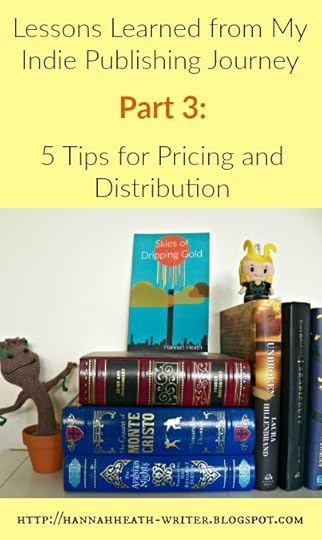 Now, before we get started. Calm down. Deep breaths. DON'T PANIC. Got it? Okay, let us begin:
Now, before we get started. Calm down. Deep breaths. DON'T PANIC. Got it? Okay, let us begin:
Tip 1: Don't Expect to Make a Ton of Money At FirstWe've all heard the stories. Indie authors who are making a decent living off of their books. Indie authors who slap their books on Amazon, then somehow end up with a movie deal. This does not happen overnight...or even to most people who aren't named Andy Weir. Keep in mind that to make a decent amount of money indie publishing, you have to:
Have a darn good story...which takes a lot of time.Have a well edited story...which can take money and a lot of time. A good marketing game...which takes a lot of time.Amazing fans...this takes a lot of time to develop, too. More than one book out on the web...also a lot of time. Notice the theme? Making money indie publishing takes a lot of time. Maybe you, unlike Han Solo, are not in this for the money. Awesome. But, if you are, be patient and willing to work long and hard.
Tip 2: Find the pricing sweet spotBoth kindle and physical books have something of a pricing sweet spot. What are these? Let me tell you:
Kindle short story pricing: 99 cents. Sweet and simple. This is the minimum price you can sell a kindle story for. If you are selling a story for 99 cents, you are only allowed a 35% royalty, which means you'll be making about 35 cents per sale. Not power money, but it's a short story, so what do you expect? Besides, having a low price will attract a lot of readers and reviewers, which strengthens your platform. It's worked well for Skies of Dripping Gold and many other short stories.
Kindle ebook pricing: $2.99 is about standard. You can try and sell for more, but if there are tons of other ebooks out there selling for less, then people are going to feel like they're being ripped off by paying more than that for yours. Which sucks, because that means you're expected to sell years of your hard work for about 3 bucks. The upside? If you sell your ebook for $2.99, you are allowed a 70% royalty (which is not a royalty amount you will ever be able to negotiate if you traditionally publish), which means you'll make about $2.00 per sale. Pretty good.
Physical book pricing: This is a harder one. Amazon uses a print-on-demand system, which means that the price for production is actually a bit more expensive. A standard 300-page novel costs about $9.00 to print. So then you have to decide: How much money do I want to make off of this deal? You obviously need to sell it for more than $9.00, otherwise you'll be losing money. But you can't sell it for too much, because then nobody will buy it. So pop onto Amazon's calculator to take a look at how much you'll be making. Then decide on pricing. $12 to $13 is awesome. $15 is reasonable and has been known to work. $18 is generally a bad idea, but may work if this is part of a series much beloved by your insanely loyal fans. $25 and you'll be put in a mental institution for believing you're J.K. Rowling.
Tip 3: If you're good at something, never do it for freeTranslation: Do NOT give your ebook away for free. You are better than that. You worked hard on that story. Respect yourself and your book. Giving away your sweat and blood for free sets a terrible precedent. You go grocery shopping and have to pay for a bag to carry it out to your car, but books should be free? No. Just no. If you are doing it for marketing reasons, try this:
Original price is above 99 cents? Lower it to 99 cents for a few days. Get some new readers, but without devaluing your work.Original price is 99 cents? That's a great deal. If somebody isn't willing to shell out less than a dollar for your story, then that's their problem.
Tip 4: Understand the CreateSpace distribution channelsCreateSpace will give you different distribution options called "Channels." Both standard distribution and expanded distribution are free.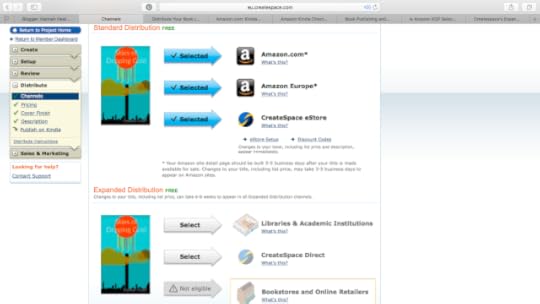
Standard distribution: You will want to select all three options for Standard Distribution (Amazon.com, Amazon Europe, and the CreateSpace store). Hands down. There's no reason not to.
Expanded distribution: Because of pricing, I can't give you a black and white answer on this one. There are three options for expanded distribution: Libraries and Academic Institutions (which makes your work available to these institutions), CreateSpace Direct (which makes your work available to certified resellers), and Bookstores and Online Retailers (which makes your work available to online and offline retailers such as Barnes & Noble, Ingram, etc). These are all great opportunities. The downside? It will increase the sales price of your book. So if you can take advantage of these channels without making your book absurdly expensive, then go for it. If not? Stay away. Those channels won't help you if nobody is buying and reviewing your stories.
Tip 5: Decide on KDP SelectEnrolling your ebook in KDP select means several things: It means that you have agreed to sell your ebook exclusively on Amazon for at least 90 days (at the end of these 90 days you can decide to drop out or renew). It also means that your book will be available for free to members of Kindle Unlimited. Amazon will pay you for each sale, though the amount will vary each month, since it's taken out of a pool. You will be increasing your readership and audience quite a bit while still getting paid. The downside? Because your book is free, people may download it without thinking. They may never read it or review it. Worse, they may read it only to realize it's not their genre, then leave you a bad review. It's honestly up to you. I have not enrolled Skies of Dripping Gold in KDP for various reasons specific to me and my story, so I can't personally give you my thoughts on the matter. I'm sure there are many other authors out there who can, so just hop on Google or tweet your favorite indie author.
I hope this indie publishing series has been helpful for you. I know that jumping into self-publishing can be hard and more than a little bit scary, but it doesn't have to be. Always feel free to reach out to other indie authors and ask for advice. You can even contact me if you want to. I don't bite, I just spew nerd quotes and sarcasm (which I promise to keep to a minimum if you need my help).
At the risk of sounding cliche, all of the difficulties of publishing will mean nothing once you actually have your book sitting on your bookshelf. Other people will see it and and think it looks awesome. But you? When you see it, it will be bathed in glory because you know you worked hard to get it on that shelf.
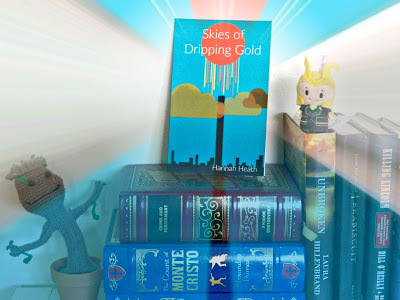 So keep going. Your story is amazing. You are amazing. You can do this.
So keep going. Your story is amazing. You are amazing. You can do this.
Have questions or tips of your own? Please leave them in the comment section!
Related articles:
Lessons Learned from My Indie Publishing Journey Part 1: 7 Tips for Getting Started
Lessons Learned from My Indie Publishing Journey Part 2: 6 Tips for Novel and eBook Formatting
12 Ridiculous Questions Non-Writers Ask Writers (And 12 Ways To Respond to Them)
Enjoy this post? Take a look around. If you like what you see, don't forget to subscribe by email for a new post every Friday!SaveSaveSaveSave
Now we come to the easiest, but still very important, part of indie publishing: Pricing and distribution methods. The rules are simple: Price your story high enough to make some profit, but low enough to still make sales. Make your story available for as many distributors as possible without over stretching yourself, losing money, or selling your soul to the industry.
 Now, before we get started. Calm down. Deep breaths. DON'T PANIC. Got it? Okay, let us begin:
Now, before we get started. Calm down. Deep breaths. DON'T PANIC. Got it? Okay, let us begin:Tip 1: Don't Expect to Make a Ton of Money At FirstWe've all heard the stories. Indie authors who are making a decent living off of their books. Indie authors who slap their books on Amazon, then somehow end up with a movie deal. This does not happen overnight...or even to most people who aren't named Andy Weir. Keep in mind that to make a decent amount of money indie publishing, you have to:
Have a darn good story...which takes a lot of time.Have a well edited story...which can take money and a lot of time. A good marketing game...which takes a lot of time.Amazing fans...this takes a lot of time to develop, too. More than one book out on the web...also a lot of time. Notice the theme? Making money indie publishing takes a lot of time. Maybe you, unlike Han Solo, are not in this for the money. Awesome. But, if you are, be patient and willing to work long and hard.
Tip 2: Find the pricing sweet spotBoth kindle and physical books have something of a pricing sweet spot. What are these? Let me tell you:
Kindle short story pricing: 99 cents. Sweet and simple. This is the minimum price you can sell a kindle story for. If you are selling a story for 99 cents, you are only allowed a 35% royalty, which means you'll be making about 35 cents per sale. Not power money, but it's a short story, so what do you expect? Besides, having a low price will attract a lot of readers and reviewers, which strengthens your platform. It's worked well for Skies of Dripping Gold and many other short stories.
Kindle ebook pricing: $2.99 is about standard. You can try and sell for more, but if there are tons of other ebooks out there selling for less, then people are going to feel like they're being ripped off by paying more than that for yours. Which sucks, because that means you're expected to sell years of your hard work for about 3 bucks. The upside? If you sell your ebook for $2.99, you are allowed a 70% royalty (which is not a royalty amount you will ever be able to negotiate if you traditionally publish), which means you'll make about $2.00 per sale. Pretty good.
Physical book pricing: This is a harder one. Amazon uses a print-on-demand system, which means that the price for production is actually a bit more expensive. A standard 300-page novel costs about $9.00 to print. So then you have to decide: How much money do I want to make off of this deal? You obviously need to sell it for more than $9.00, otherwise you'll be losing money. But you can't sell it for too much, because then nobody will buy it. So pop onto Amazon's calculator to take a look at how much you'll be making. Then decide on pricing. $12 to $13 is awesome. $15 is reasonable and has been known to work. $18 is generally a bad idea, but may work if this is part of a series much beloved by your insanely loyal fans. $25 and you'll be put in a mental institution for believing you're J.K. Rowling.
Tip 3: If you're good at something, never do it for freeTranslation: Do NOT give your ebook away for free. You are better than that. You worked hard on that story. Respect yourself and your book. Giving away your sweat and blood for free sets a terrible precedent. You go grocery shopping and have to pay for a bag to carry it out to your car, but books should be free? No. Just no. If you are doing it for marketing reasons, try this:
Original price is above 99 cents? Lower it to 99 cents for a few days. Get some new readers, but without devaluing your work.Original price is 99 cents? That's a great deal. If somebody isn't willing to shell out less than a dollar for your story, then that's their problem.
Tip 4: Understand the CreateSpace distribution channelsCreateSpace will give you different distribution options called "Channels." Both standard distribution and expanded distribution are free.

Standard distribution: You will want to select all three options for Standard Distribution (Amazon.com, Amazon Europe, and the CreateSpace store). Hands down. There's no reason not to.
Expanded distribution: Because of pricing, I can't give you a black and white answer on this one. There are three options for expanded distribution: Libraries and Academic Institutions (which makes your work available to these institutions), CreateSpace Direct (which makes your work available to certified resellers), and Bookstores and Online Retailers (which makes your work available to online and offline retailers such as Barnes & Noble, Ingram, etc). These are all great opportunities. The downside? It will increase the sales price of your book. So if you can take advantage of these channels without making your book absurdly expensive, then go for it. If not? Stay away. Those channels won't help you if nobody is buying and reviewing your stories.
Tip 5: Decide on KDP SelectEnrolling your ebook in KDP select means several things: It means that you have agreed to sell your ebook exclusively on Amazon for at least 90 days (at the end of these 90 days you can decide to drop out or renew). It also means that your book will be available for free to members of Kindle Unlimited. Amazon will pay you for each sale, though the amount will vary each month, since it's taken out of a pool. You will be increasing your readership and audience quite a bit while still getting paid. The downside? Because your book is free, people may download it without thinking. They may never read it or review it. Worse, they may read it only to realize it's not their genre, then leave you a bad review. It's honestly up to you. I have not enrolled Skies of Dripping Gold in KDP for various reasons specific to me and my story, so I can't personally give you my thoughts on the matter. I'm sure there are many other authors out there who can, so just hop on Google or tweet your favorite indie author.
I hope this indie publishing series has been helpful for you. I know that jumping into self-publishing can be hard and more than a little bit scary, but it doesn't have to be. Always feel free to reach out to other indie authors and ask for advice. You can even contact me if you want to. I don't bite, I just spew nerd quotes and sarcasm (which I promise to keep to a minimum if you need my help).
At the risk of sounding cliche, all of the difficulties of publishing will mean nothing once you actually have your book sitting on your bookshelf. Other people will see it and and think it looks awesome. But you? When you see it, it will be bathed in glory because you know you worked hard to get it on that shelf.
 So keep going. Your story is amazing. You are amazing. You can do this.
So keep going. Your story is amazing. You are amazing. You can do this.Have questions or tips of your own? Please leave them in the comment section!
Related articles:
Lessons Learned from My Indie Publishing Journey Part 1: 7 Tips for Getting Started
Lessons Learned from My Indie Publishing Journey Part 2: 6 Tips for Novel and eBook Formatting
12 Ridiculous Questions Non-Writers Ask Writers (And 12 Ways To Respond to Them)
Enjoy this post? Take a look around. If you like what you see, don't forget to subscribe by email for a new post every Friday!SaveSaveSaveSave

Published on October 14, 2016 07:58
October 10, 2016
Lessons Learned from My Indie Publishing Journey Part 2: 6 Tips for Novel and eBook Formatting
I'm not a fan of writing rules, but I do have a few I hold to. One of them is that, if I get 3 individual requests for a post, I will write said post.
After writing Skies of Dripping Gold, I conveniently ignored the first 4 requests for a post on how to indie publish because, honestly, that's a tall, intimidating order. But then the 5th request rolled around and I realized I couldn't put it off any longer. So I accepted it graciously:
[image error] Because indie publishing is a rather involved process, I decided to turn it into a blog series. Part 1 can be found here, which is an overview of how to jump into indie publishing. Part 2 is about...*gulps* *looks over shoulder* *whispers* formatting.
I'll have bad dreams for weeks after writing this. I hope you're satisfied.
Okay, I'm kidding. Formatting is something of a bad word among indie publishers, but it actually isn't terribly difficult. It's just a time suck. Let me give you some pointers:

Tip 1: DON'T PANICYes, I'm aware that I already told you that a few times in Part 1. It seemed worth repeating.
Tip 2: Don't forget about the front matterWhat is front matter? Simple. It's the title page, copyright page, dedication page, and preface (if you have one). Read about that here.
A note on the copyright page: You do not have to buy a copyright. You wrote it? You own it. Those are the laws. That being said, it is a good idea to reiterate this in the body of your work. For example, I put this in my physical copy: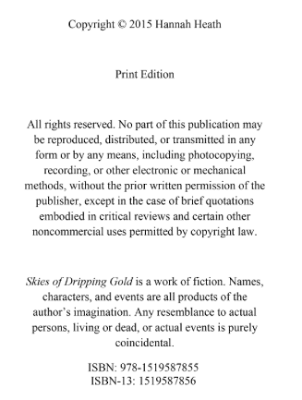 Note: my ebook does not include ISBN numbers. Neither should yours.
Note: my ebook does not include ISBN numbers. Neither should yours.
Yes, these laws go without saying, but I put them in anyway just to state: "This is my precious. If you mess with it, there is no measure to how fast and how hard I will bring this fight to your doorstep." So while you should put something like the above in your story, you don't actually have to dole out money for a copyright.
Tip 3: Use Amazon's formatting guidelinesRead them and follow them like Bucky Barnes' life depends on it.
Kindle: KDP (Kindle Direct Publishing) has some simple guidelines here. You can find a lot of the necessary information on that page. The rules are fairly simple:
Use page breaks. Do not hit "enter" at the end of a line. Use page indentations rather than using the "tab" key.Don't copy and paste images. Use Doc or Docx. KDP hates PDF, so if you'd like to keep your cursing to a minimum, don't use PDF. Making these corrections alone will take quite a bit of time, but it's pretty easy to understand. If you run up against something you don't understand, type your question directly into the KDP site. The answers will be there 99% of the time. You just have to be patient. And the other 1% of the time? *slaps upside the head* What part of Tip 1 did you not understand?
Physical: CreateSpace is a bit trickier. For formatting the interior, I recommend using this article first and this one for supplement. Have questions? Refer to these articles. Still have questions? Look at this page. It has dozens of articles written for frustrated, confused writers just like you and me.
Unlike KDP, CreateSpace prefers that you format in Word, but then convert to PDF before uploading.
Now, getting it formatted is going to take a long time. Don't rush it. And don't worry about missing something. Amazon has a failsafe (See Tip 4).
Tip 3: Use the formatted template for physical copiesPlease. There's no reason not to. CreateSpace will give you a formatted template with all of the correct settings:
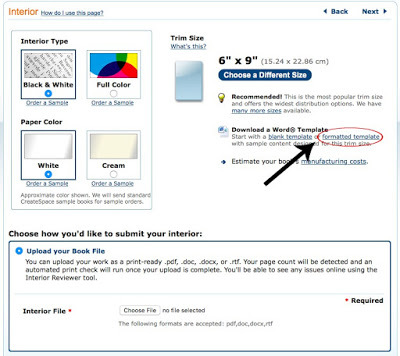
Take advantage of this. Will formatting still take a lot of time? Yes. But it will take less time if you do it this way.
Tip 4: Use the Reviewer/Previewer resourcesThat file you're sure is correct? It's not. Trust me. Thankfully, Amazon has not overestimated your competence and has a program to keep you from utterly failing.
Physical: Createspace will give you the option to use their "Interior Reviewer." Do NOT skip this step. Amazon will load your PDF into their review system. It takes a long time to load, so you'll probably be staring at this screen for a while:
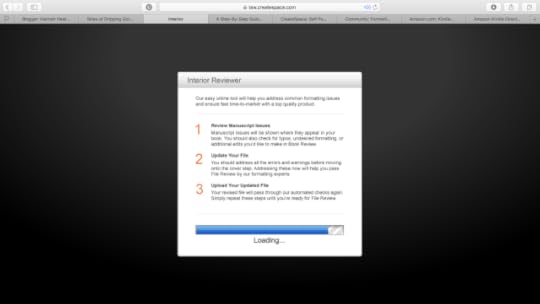
Once it has loaded, it will tell you all about the things you did wrong. Now you can go back to the file, make corrections, then re-upload into the Reviewer. More things will be wrong. Repeat the process until you see only green checkmarks. This will take several tries. That's okay. After all, why do we fall? So that we can learn to pick ourselves up.
Kindle: For Kindle publishing, you will be given the option to use an "Online Previewer," which is similar to the Createspace "Interior Reviewer." Use it. It will show you how your story will appear on all different Kindle devices: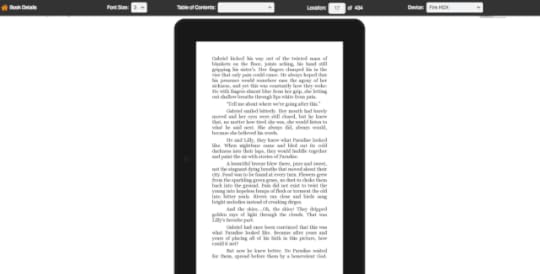
Go over this with a fine tooth comb. Any glaring formatting issues will be apparent.
Tip 5: You can design your own cover...given you have some patience and skillsYes, you totally can design your own cover. No, you don't need super fancy digital tools. You just need to know how to get your image at the correct DPI and how to follow the Amazon guidelines. But I'm not going to lie: It's a huge pain. Getting the dimensions right is very difficult and will take a lot of time.
Kindle: Kindle cover guidelines are here. Pay close attention to pixel dimension and DPI. If you get this wrong, your cover will be distorted. You can either upload your very own cover, or you can use Kindle Cover Creator. I made my own image, then uploaded it into Kindle Cover Creator to add text: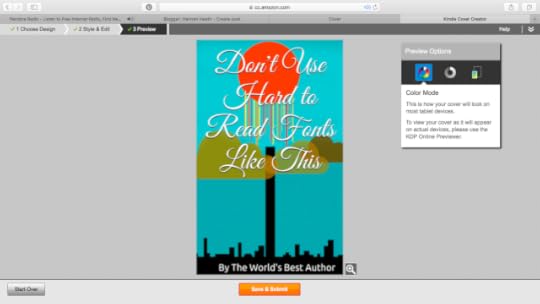
Physical: You can make your own PDF file (instruction here), but you can also use their Cover Creator. I thought PDF sounded too involved for my first time, so I went with Cover Creator. They allow you to choose from a plethora of cover designs. The design I used was "The Palm," which allowed me to create the cover image, then upload it to Cover Creator. I recommend this, as it allows more control. Take a look: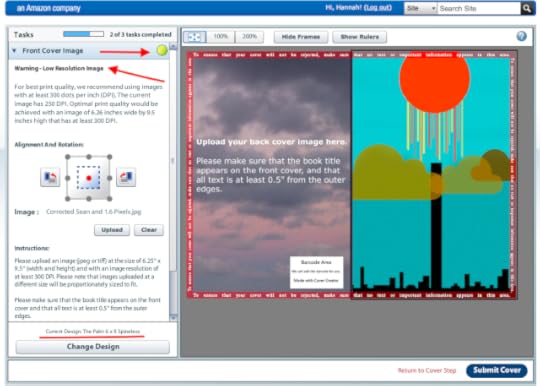 If the cover is completely incorrect, there will be a red dot rather than a green dot next to the "Front Cover Image" tab. If there are small problems, you will see a warning (like the one above). Also, note that the image I have put in Cover Creator for this example is less than ideal because parts of it will be cut out when printed. Also, if you choose to use "The Palm" design, you will have to upload a picture with the title and your name on it, as it will not put this information on it for you.
If the cover is completely incorrect, there will be a red dot rather than a green dot next to the "Front Cover Image" tab. If there are small problems, you will see a warning (like the one above). Also, note that the image I have put in Cover Creator for this example is less than ideal because parts of it will be cut out when printed. Also, if you choose to use "The Palm" design, you will have to upload a picture with the title and your name on it, as it will not put this information on it for you.
Note for both ebook and book covers: You want your cover to look nice as a small thumbnail, as this is how it will appear in Amazon search results. Take this into account when designing your cover.
Tip 6: Purchase a proof copy of your physical copyYou don't want to order your book along with all the other peasants. Several weeks before publication, order a "proof copy" of your story so that you can look it over before anyone else sees it. Make sure it looks the way you want it to. If it doesn't, you can make changes before the book is made public.
See? Not so scary. The important fact to remember when Amazon indie publishing is this: It's not hard. It just takes a lot of work, time, and patience. Clearly all qualities that you possess if you have managed to write and edit a book.
Do you still have questions about formatting? Please let me know! And, if you have already indie published, leave your expert opinion below to help others out!
Enjoy this post? I'll be finishing up the series with Part 3: Tips on Pricing and Distributing. This will be released this Friday (the 14th). Subscribe by email to have it delivered straight to your inbox!
Related articles:
Lessons Learned from My Indie Publishing Journey Part 1: 7 Tips for Getting Started
5 Tips for Creating an Eye-Catching Book Title
How to Format a Magazine Submission in 15 StepsSaveSave
SaveSave
After writing Skies of Dripping Gold, I conveniently ignored the first 4 requests for a post on how to indie publish because, honestly, that's a tall, intimidating order. But then the 5th request rolled around and I realized I couldn't put it off any longer. So I accepted it graciously:
[image error] Because indie publishing is a rather involved process, I decided to turn it into a blog series. Part 1 can be found here, which is an overview of how to jump into indie publishing. Part 2 is about...*gulps* *looks over shoulder* *whispers* formatting.
I'll have bad dreams for weeks after writing this. I hope you're satisfied.
Okay, I'm kidding. Formatting is something of a bad word among indie publishers, but it actually isn't terribly difficult. It's just a time suck. Let me give you some pointers:

Tip 1: DON'T PANICYes, I'm aware that I already told you that a few times in Part 1. It seemed worth repeating.
Tip 2: Don't forget about the front matterWhat is front matter? Simple. It's the title page, copyright page, dedication page, and preface (if you have one). Read about that here.
A note on the copyright page: You do not have to buy a copyright. You wrote it? You own it. Those are the laws. That being said, it is a good idea to reiterate this in the body of your work. For example, I put this in my physical copy:
 Note: my ebook does not include ISBN numbers. Neither should yours.
Note: my ebook does not include ISBN numbers. Neither should yours.Yes, these laws go without saying, but I put them in anyway just to state: "This is my precious. If you mess with it, there is no measure to how fast and how hard I will bring this fight to your doorstep." So while you should put something like the above in your story, you don't actually have to dole out money for a copyright.
Tip 3: Use Amazon's formatting guidelinesRead them and follow them like Bucky Barnes' life depends on it.
Kindle: KDP (Kindle Direct Publishing) has some simple guidelines here. You can find a lot of the necessary information on that page. The rules are fairly simple:
Use page breaks. Do not hit "enter" at the end of a line. Use page indentations rather than using the "tab" key.Don't copy and paste images. Use Doc or Docx. KDP hates PDF, so if you'd like to keep your cursing to a minimum, don't use PDF. Making these corrections alone will take quite a bit of time, but it's pretty easy to understand. If you run up against something you don't understand, type your question directly into the KDP site. The answers will be there 99% of the time. You just have to be patient. And the other 1% of the time? *slaps upside the head* What part of Tip 1 did you not understand?
Physical: CreateSpace is a bit trickier. For formatting the interior, I recommend using this article first and this one for supplement. Have questions? Refer to these articles. Still have questions? Look at this page. It has dozens of articles written for frustrated, confused writers just like you and me.
Unlike KDP, CreateSpace prefers that you format in Word, but then convert to PDF before uploading.
Now, getting it formatted is going to take a long time. Don't rush it. And don't worry about missing something. Amazon has a failsafe (See Tip 4).
Tip 3: Use the formatted template for physical copiesPlease. There's no reason not to. CreateSpace will give you a formatted template with all of the correct settings:

Take advantage of this. Will formatting still take a lot of time? Yes. But it will take less time if you do it this way.
Tip 4: Use the Reviewer/Previewer resourcesThat file you're sure is correct? It's not. Trust me. Thankfully, Amazon has not overestimated your competence and has a program to keep you from utterly failing.
Physical: Createspace will give you the option to use their "Interior Reviewer." Do NOT skip this step. Amazon will load your PDF into their review system. It takes a long time to load, so you'll probably be staring at this screen for a while:

Once it has loaded, it will tell you all about the things you did wrong. Now you can go back to the file, make corrections, then re-upload into the Reviewer. More things will be wrong. Repeat the process until you see only green checkmarks. This will take several tries. That's okay. After all, why do we fall? So that we can learn to pick ourselves up.
Kindle: For Kindle publishing, you will be given the option to use an "Online Previewer," which is similar to the Createspace "Interior Reviewer." Use it. It will show you how your story will appear on all different Kindle devices:

Go over this with a fine tooth comb. Any glaring formatting issues will be apparent.
Tip 5: You can design your own cover...given you have some patience and skillsYes, you totally can design your own cover. No, you don't need super fancy digital tools. You just need to know how to get your image at the correct DPI and how to follow the Amazon guidelines. But I'm not going to lie: It's a huge pain. Getting the dimensions right is very difficult and will take a lot of time.
Kindle: Kindle cover guidelines are here. Pay close attention to pixel dimension and DPI. If you get this wrong, your cover will be distorted. You can either upload your very own cover, or you can use Kindle Cover Creator. I made my own image, then uploaded it into Kindle Cover Creator to add text:

Physical: You can make your own PDF file (instruction here), but you can also use their Cover Creator. I thought PDF sounded too involved for my first time, so I went with Cover Creator. They allow you to choose from a plethora of cover designs. The design I used was "The Palm," which allowed me to create the cover image, then upload it to Cover Creator. I recommend this, as it allows more control. Take a look:
 If the cover is completely incorrect, there will be a red dot rather than a green dot next to the "Front Cover Image" tab. If there are small problems, you will see a warning (like the one above). Also, note that the image I have put in Cover Creator for this example is less than ideal because parts of it will be cut out when printed. Also, if you choose to use "The Palm" design, you will have to upload a picture with the title and your name on it, as it will not put this information on it for you.
If the cover is completely incorrect, there will be a red dot rather than a green dot next to the "Front Cover Image" tab. If there are small problems, you will see a warning (like the one above). Also, note that the image I have put in Cover Creator for this example is less than ideal because parts of it will be cut out when printed. Also, if you choose to use "The Palm" design, you will have to upload a picture with the title and your name on it, as it will not put this information on it for you.
Note for both ebook and book covers: You want your cover to look nice as a small thumbnail, as this is how it will appear in Amazon search results. Take this into account when designing your cover.
Tip 6: Purchase a proof copy of your physical copyYou don't want to order your book along with all the other peasants. Several weeks before publication, order a "proof copy" of your story so that you can look it over before anyone else sees it. Make sure it looks the way you want it to. If it doesn't, you can make changes before the book is made public.
See? Not so scary. The important fact to remember when Amazon indie publishing is this: It's not hard. It just takes a lot of work, time, and patience. Clearly all qualities that you possess if you have managed to write and edit a book.
Do you still have questions about formatting? Please let me know! And, if you have already indie published, leave your expert opinion below to help others out!
Enjoy this post? I'll be finishing up the series with Part 3: Tips on Pricing and Distributing. This will be released this Friday (the 14th). Subscribe by email to have it delivered straight to your inbox!
Related articles:
Lessons Learned from My Indie Publishing Journey Part 1: 7 Tips for Getting Started
5 Tips for Creating an Eye-Catching Book Title
How to Format a Magazine Submission in 15 StepsSaveSave
SaveSave

Published on October 10, 2016 08:27
October 7, 2016
Lessons Learned from My Indie Publishing Journey Part 1: 7 Tips for Getting Started
You're coming to me for Amazon indie publishing help? You think you're so cool. It's not cool to get help! Publish for yourself, you little gargoyle!
Sorry. I've been really wanting to work that reference in somewhere.
Let's start over.
My name is Hannah Heath. On December 5th of 2015, I indie published my first story, Skies of Dripping Gold. People liked it. People asked me to write a post about my indie publishing journey. People said they wanted to hear what I had to say. I ignored said people because the thought of writing about how to indie publish intimidated me. But now I've run out of excuses for avoiding this topic, so here I am, ready to talk about Amazon indie publishing.
That being said, this post is not going to be at all similar to the other posts you've read about indie publishing. Why? Because my style of doing practically anything is about as unorthodox as you can get. I don't lay out large, detailed plans. I just...do things.
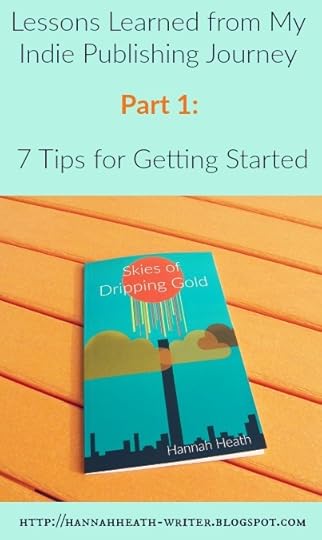 When I jumped into indie publishing, I didn't ask anybody for help. I didn't read any books on the topic. I didn't watch any tutorials or join a workshop. I didn't pay anybody to do anything for me. Basically, I didn't do any of the things that people tell you you should do in order to indie publish.
When I jumped into indie publishing, I didn't ask anybody for help. I didn't read any books on the topic. I didn't watch any tutorials or join a workshop. I didn't pay anybody to do anything for me. Basically, I didn't do any of the things that people tell you you should do in order to indie publish.
And it actually worked.
How did I do this? I'll tell you: I don't know. But I have some pretty good guesses. So, if you're looking to indie publish a story, want to do it yourself without throwing down a ton of cash, and don't feel like signing away years of your life doing research, then you've come to the right place.
Unlike most of my posts, this will be a 3 part series. Today, I'm posting about the general tips and tricks that I personally found helpful and think that you will, too. Monday, I'll do a post about all the gritty details: How to format both the story and the book cover. And next Friday I'll post on pricing and distribution.
Here are 7 tips I learned from my indie publishing experience that I think will benefit you:
Tip 1: DON'T PANICEverything is going to be okay. Indie publishing is not as intimidating as it seems. It is time consuming, but it is not impossibly difficult. If you are clever enough to have been able to write a short story/novella/book/Great American Novel, then you are clever enough to figure out how to do some publishing through Amazon. So take a moment to scream (preferably into a pillow...no need to alarm the neighbors), then breathe deeply, say a prayer or sing kumbaya or eat some chocolate or do whatever it is you need to do to stay centered, then sit down at your computer. You're going to do great.
Tip 2: Don't listen to the naysayersEver, especially if that naysayer is yourself. You can do this. Indie publishing is time consuming and it can be difficult, but it is nowhere near impossible. Some people will tell you that indie publishing is expensive. It doesn't have to be. Maybe you think you're too old to be all tech-ish and indie. That's not true. Maybe you think you're too young and inexperienced. Again, not true. Maybe you think that you aren't talented enough or don't have enough time or simply aren't smart enough. All of these are untrue. If you want it, you can make it happen. So go for it.
Tip 3: You don't need Batman-level planning skills to pull indie publishing offMany people are wary of indie publishing because there are so many different aspects to consider: legalities, formatting, marketing, pricing. People think that they have to read tons of blogs posts, join a workshop, talk to other experienced indie authors, map out a detailed plan, craft a utility belt, and build a bat cave before setting out on the publishing road. You simply do not have to do any of this. If it helps you to plan the heck out of your projects, then do so. But if it stresses you out? Don't. Indie publishing is a very fluid process. You cannot plan all of it ahead of time, so don't feel like you have to try. I jumped in head first without knowing what on earth I was doing and I'm still alive, so it can't possibly be as bad as you think.
Tip 4: You don't need Batman-level moneyIndie publishing does not have to be expensive. Do you want to know how much money I spent on publishing Skies of Dripping Gold? $20. And that was to buy and ship an advanced proof copy of my story so that I could look it over before it went live. So no, it doesn't have to be expensive. You don't have to pay somebody to format your novel. You don't need to hire a lawyer. If you have the right skills, you can design your own cover. Honestly, the only part that may stick you is hiring a professional editor, and if your story is short enough (like mine), you don't even need one of those. So don't panic about the money. Indie publishing can be expensive, but it doesn't have to be.
Tip 5: After publication, you can still make changesYep. If you publish your story and then notice a few typos, you can just edit the original document and re-upload it. You can also go back in and change or make corrections to the cover. I'm not telling you this so that you will be careless about your publishing methods. Ideally, you don't want to have to go back in and make changes. However, I think it will help stave off the panic if you know any errors you make aren't completely permanent. Seriously: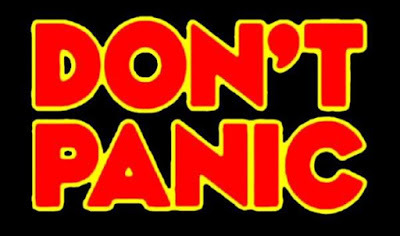
Tip 6: It's a good idea for your first indie publishing project to be a small one I cannot stress this enough. Indie publishing can be dizzying, so start small. Skies of Dripping Gold is a short story. I can only imagine how difficult it would have been if I had tried to jump into indie publishing with a 300-page novel rather than a 40 page story. So, if at all possible, test the waters with a short story or novella. Not only is this good marketing for your future novel, but it will help you find how comfortable you are with all of the different aspects of indie publishing: the legalities, the formatting, the pricing, the cover designing. Can you jump right in and do a novel for your first project? Heck yes! Go for it. I applaud you. Will it be less of a shock if you start small? Definitely.
Tip 7: Look at other indie published worksDo you have indie authors you trust? Go look at their books. See how they formatted, what they did for copyright, where they placed their acknowledgment page, how they did their cover. Look at a ton of indie books to get an idea of what is going on. And don't be afraid to ask your favorite indie people for help. Chances are they'll be more than happy to lend some tips.
Basically, the point of this post is this: You don't need to be Batman to indie publish. You don't have to be a particularly good planner, a millionaire, or a genius. You just need to be willing to work long and hard. Indie publishing is 40% knowledge that you borrowed from Google, 50% improvising, and 10% cussing and wondering why you started the darn project.
Are you thinking of indie publishing? I'd love to hear any thoughts or questions you may have! And if you have already indie published, please leave a comment below with some of the top lessons you learned from the process.
Enjoyed this post? Stay tuned for part 2 on Monday and part 3 on Friday the 14th. Subscribe by email to have them delivered straight to your inbox! Need tips on book launching? Check out this post full of tips from fellow indie authors!
Related articles: How to Write an Awesome Jacket Blurb for Your Novel11 Tips for Building a Successful Writer's PlatformThe 5-Star Rating System: What Book Reviewers Mean Vs How Indie Authors Take It

Sorry. I've been really wanting to work that reference in somewhere.
Let's start over.
My name is Hannah Heath. On December 5th of 2015, I indie published my first story, Skies of Dripping Gold. People liked it. People asked me to write a post about my indie publishing journey. People said they wanted to hear what I had to say. I ignored said people because the thought of writing about how to indie publish intimidated me. But now I've run out of excuses for avoiding this topic, so here I am, ready to talk about Amazon indie publishing.
That being said, this post is not going to be at all similar to the other posts you've read about indie publishing. Why? Because my style of doing practically anything is about as unorthodox as you can get. I don't lay out large, detailed plans. I just...do things.
 When I jumped into indie publishing, I didn't ask anybody for help. I didn't read any books on the topic. I didn't watch any tutorials or join a workshop. I didn't pay anybody to do anything for me. Basically, I didn't do any of the things that people tell you you should do in order to indie publish.
When I jumped into indie publishing, I didn't ask anybody for help. I didn't read any books on the topic. I didn't watch any tutorials or join a workshop. I didn't pay anybody to do anything for me. Basically, I didn't do any of the things that people tell you you should do in order to indie publish.And it actually worked.
How did I do this? I'll tell you: I don't know. But I have some pretty good guesses. So, if you're looking to indie publish a story, want to do it yourself without throwing down a ton of cash, and don't feel like signing away years of your life doing research, then you've come to the right place.
Unlike most of my posts, this will be a 3 part series. Today, I'm posting about the general tips and tricks that I personally found helpful and think that you will, too. Monday, I'll do a post about all the gritty details: How to format both the story and the book cover. And next Friday I'll post on pricing and distribution.
Here are 7 tips I learned from my indie publishing experience that I think will benefit you:
Tip 1: DON'T PANICEverything is going to be okay. Indie publishing is not as intimidating as it seems. It is time consuming, but it is not impossibly difficult. If you are clever enough to have been able to write a short story/novella/book/Great American Novel, then you are clever enough to figure out how to do some publishing through Amazon. So take a moment to scream (preferably into a pillow...no need to alarm the neighbors), then breathe deeply, say a prayer or sing kumbaya or eat some chocolate or do whatever it is you need to do to stay centered, then sit down at your computer. You're going to do great.
Tip 2: Don't listen to the naysayersEver, especially if that naysayer is yourself. You can do this. Indie publishing is time consuming and it can be difficult, but it is nowhere near impossible. Some people will tell you that indie publishing is expensive. It doesn't have to be. Maybe you think you're too old to be all tech-ish and indie. That's not true. Maybe you think you're too young and inexperienced. Again, not true. Maybe you think that you aren't talented enough or don't have enough time or simply aren't smart enough. All of these are untrue. If you want it, you can make it happen. So go for it.
Tip 3: You don't need Batman-level planning skills to pull indie publishing offMany people are wary of indie publishing because there are so many different aspects to consider: legalities, formatting, marketing, pricing. People think that they have to read tons of blogs posts, join a workshop, talk to other experienced indie authors, map out a detailed plan, craft a utility belt, and build a bat cave before setting out on the publishing road. You simply do not have to do any of this. If it helps you to plan the heck out of your projects, then do so. But if it stresses you out? Don't. Indie publishing is a very fluid process. You cannot plan all of it ahead of time, so don't feel like you have to try. I jumped in head first without knowing what on earth I was doing and I'm still alive, so it can't possibly be as bad as you think.
Tip 4: You don't need Batman-level moneyIndie publishing does not have to be expensive. Do you want to know how much money I spent on publishing Skies of Dripping Gold? $20. And that was to buy and ship an advanced proof copy of my story so that I could look it over before it went live. So no, it doesn't have to be expensive. You don't have to pay somebody to format your novel. You don't need to hire a lawyer. If you have the right skills, you can design your own cover. Honestly, the only part that may stick you is hiring a professional editor, and if your story is short enough (like mine), you don't even need one of those. So don't panic about the money. Indie publishing can be expensive, but it doesn't have to be.
Tip 5: After publication, you can still make changesYep. If you publish your story and then notice a few typos, you can just edit the original document and re-upload it. You can also go back in and change or make corrections to the cover. I'm not telling you this so that you will be careless about your publishing methods. Ideally, you don't want to have to go back in and make changes. However, I think it will help stave off the panic if you know any errors you make aren't completely permanent. Seriously:

Tip 6: It's a good idea for your first indie publishing project to be a small one I cannot stress this enough. Indie publishing can be dizzying, so start small. Skies of Dripping Gold is a short story. I can only imagine how difficult it would have been if I had tried to jump into indie publishing with a 300-page novel rather than a 40 page story. So, if at all possible, test the waters with a short story or novella. Not only is this good marketing for your future novel, but it will help you find how comfortable you are with all of the different aspects of indie publishing: the legalities, the formatting, the pricing, the cover designing. Can you jump right in and do a novel for your first project? Heck yes! Go for it. I applaud you. Will it be less of a shock if you start small? Definitely.
Tip 7: Look at other indie published worksDo you have indie authors you trust? Go look at their books. See how they formatted, what they did for copyright, where they placed their acknowledgment page, how they did their cover. Look at a ton of indie books to get an idea of what is going on. And don't be afraid to ask your favorite indie people for help. Chances are they'll be more than happy to lend some tips.
Basically, the point of this post is this: You don't need to be Batman to indie publish. You don't have to be a particularly good planner, a millionaire, or a genius. You just need to be willing to work long and hard. Indie publishing is 40% knowledge that you borrowed from Google, 50% improvising, and 10% cussing and wondering why you started the darn project.
Are you thinking of indie publishing? I'd love to hear any thoughts or questions you may have! And if you have already indie published, please leave a comment below with some of the top lessons you learned from the process.
Enjoyed this post? Stay tuned for part 2 on Monday and part 3 on Friday the 14th. Subscribe by email to have them delivered straight to your inbox! Need tips on book launching? Check out this post full of tips from fellow indie authors!
Related articles: How to Write an Awesome Jacket Blurb for Your Novel11 Tips for Building a Successful Writer's PlatformThe 5-Star Rating System: What Book Reviewers Mean Vs How Indie Authors Take It

Published on October 07, 2016 08:24
September 30, 2016
A Review of The Brothers Karamazov by Fyodor Dostoevsky
What is this? Hannah doing a book review? What has the world come to?
I know, I know. I usually do a book review combined with a recipe inspired by said book. Well, that's not going to work this month because I royally messed up the recipe I tried for The Brothers Karamazov , September's book of the month.
I tried to make kvass, a Russian fermented rye bread drink. Ideally, this drink is nonalcoholic, though sometimes it has a low (0.5 to 1%) alcohol content. Given that I don't drink, I wa...
I know, I know. I usually do a book review combined with a recipe inspired by said book. Well, that's not going to work this month because I royally messed up the recipe I tried for The Brothers Karamazov , September's book of the month.
I tried to make kvass, a Russian fermented rye bread drink. Ideally, this drink is nonalcoholic, though sometimes it has a low (0.5 to 1%) alcohol content. Given that I don't drink, I wa...
Published on September 30, 2016 20:31



